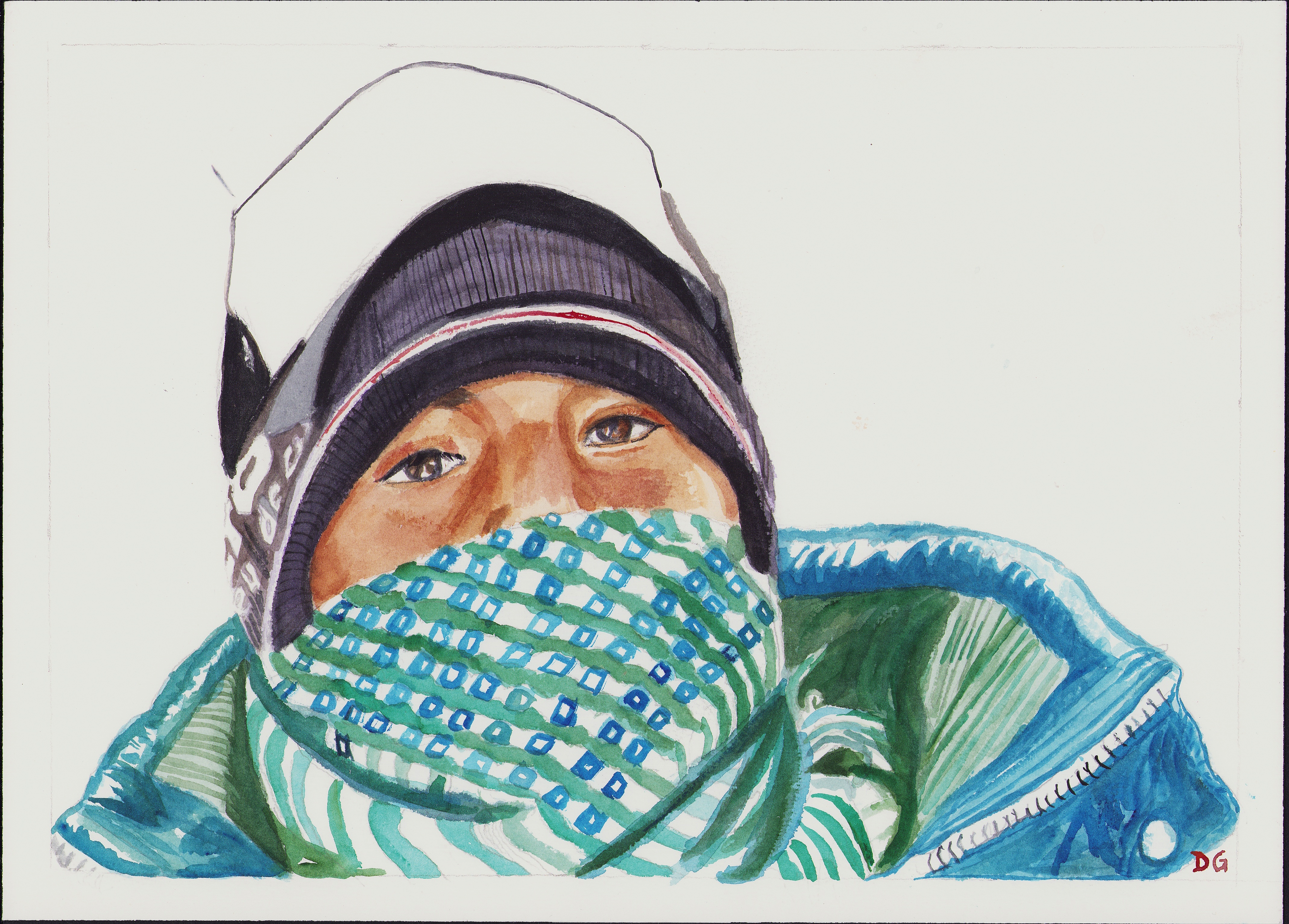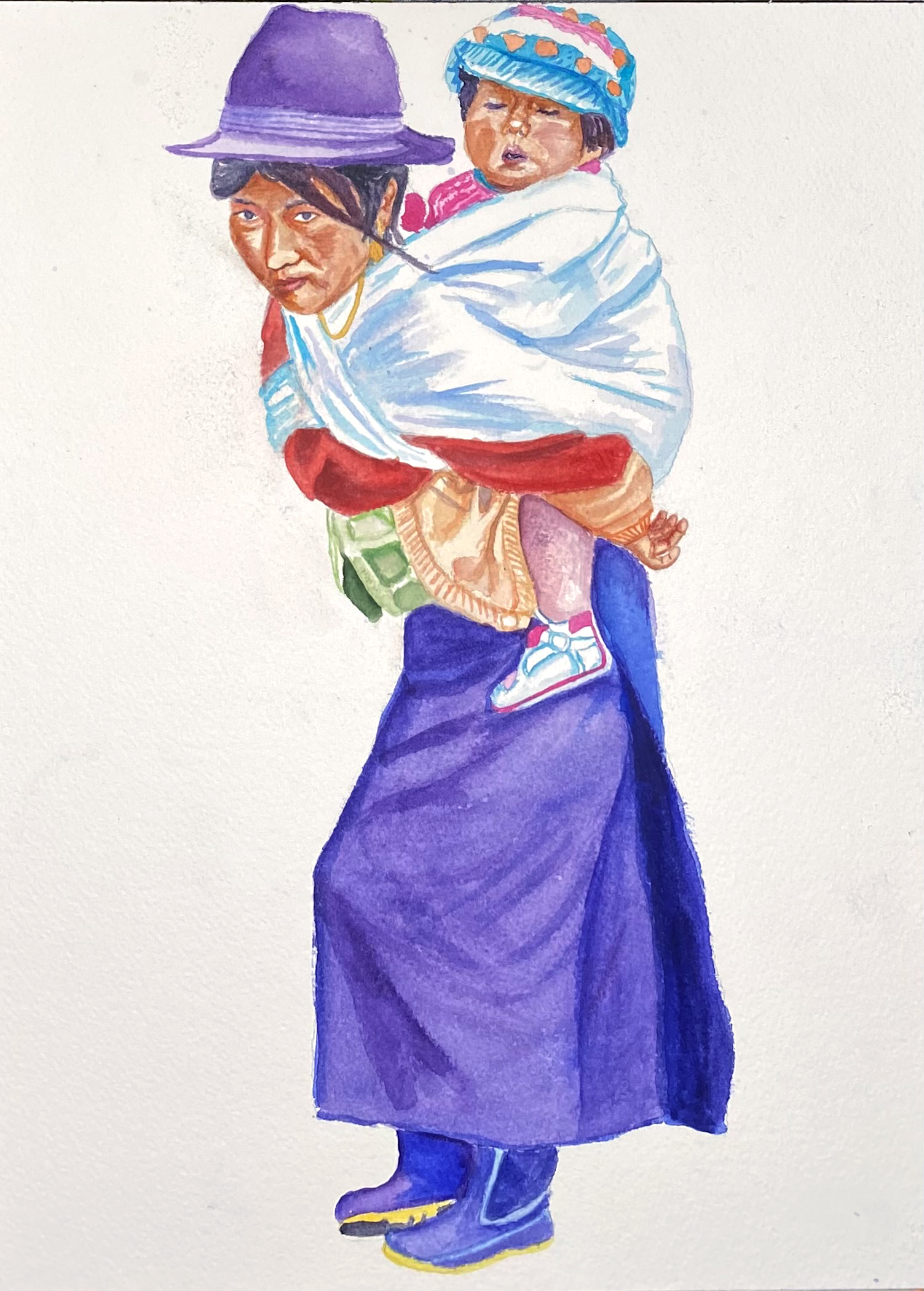Work samples
-
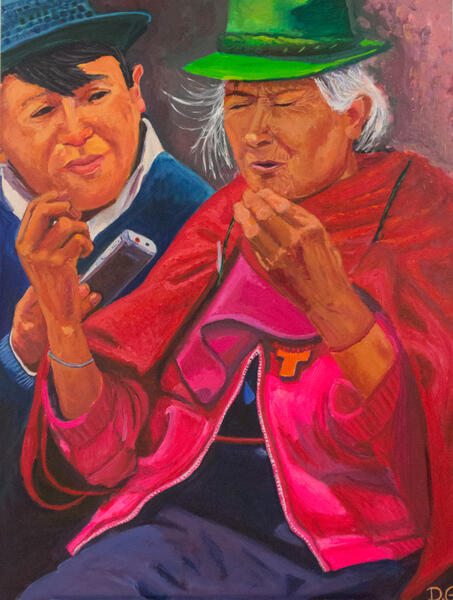 Wisdom, 2018.jpgWisdom. This painting entitled Wisdom is the first of the series because it embodies the wisdom that lies in the teaching of the indigenous people. This old lady also reminds me of my grandmother, and the fact that somehow, I’m trying to retrieve that history through these paintings. The guy with the audio recording device is doing just that recording his history as well. I didn’t have the privilege to get those stories from my grandma first hand because she passed when I was really young. However, I believe that these paintings help me share the colors that cultural history of that linage.
Wisdom, 2018.jpgWisdom. This painting entitled Wisdom is the first of the series because it embodies the wisdom that lies in the teaching of the indigenous people. This old lady also reminds me of my grandmother, and the fact that somehow, I’m trying to retrieve that history through these paintings. The guy with the audio recording device is doing just that recording his history as well. I didn’t have the privilege to get those stories from my grandma first hand because she passed when I was really young. However, I believe that these paintings help me share the colors that cultural history of that linage. -
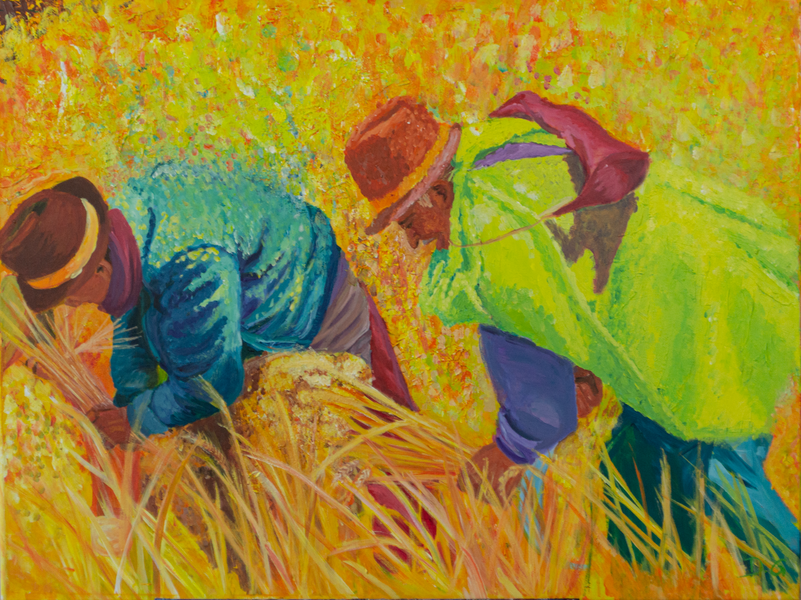 Cosechando.Squarepace.pngCosechando / Harvesting.This painting is very representative of the recurring style of paint application, for my Jahuay series, the small strokes of colors mimic the blurry sentiment of a memory, thus personifying the 500 years of history that the Jahuay songs embody. It also shows an intimate view of the workers. *This painting is currently part of a private collection in Connecticut
Cosechando.Squarepace.pngCosechando / Harvesting.This painting is very representative of the recurring style of paint application, for my Jahuay series, the small strokes of colors mimic the blurry sentiment of a memory, thus personifying the 500 years of history that the Jahuay songs embody. It also shows an intimate view of the workers. *This painting is currently part of a private collection in Connecticut -
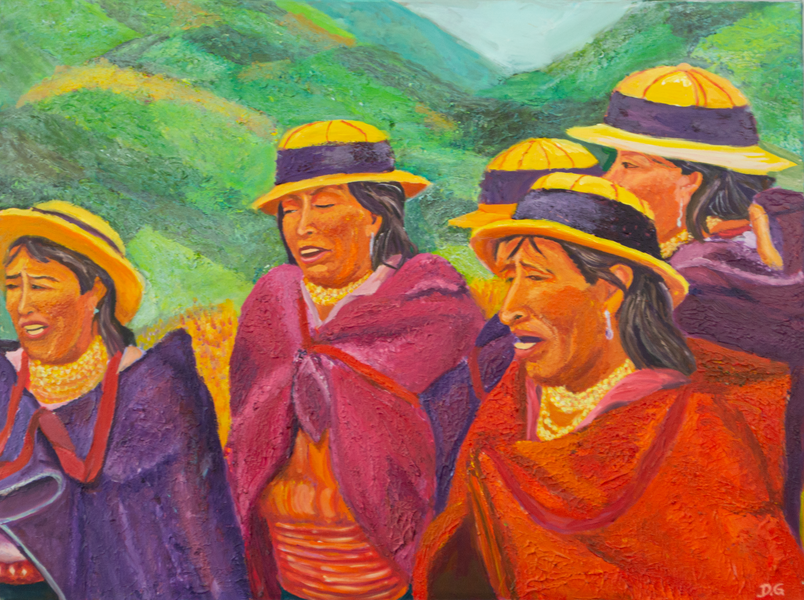 Cantoras de Jahuay/ Jahuay Singers..pngCantoras de Jahuay/ Jahuay Singers.The women’s voices are higher in pitch than the men’s voices, which serve to complement each other. Their Jahuay response to the Paki’s verses is both a celebratory chant of encouragement while at the same time the Jahuay response also the sound is sometimes daunting in its moaning quality. This painting was sold to the Museo de Pasillo (Museum of the Pasillo)in Quito Ecuador 2018, and is now a part of their permanent collection
Cantoras de Jahuay/ Jahuay Singers..pngCantoras de Jahuay/ Jahuay Singers.The women’s voices are higher in pitch than the men’s voices, which serve to complement each other. Their Jahuay response to the Paki’s verses is both a celebratory chant of encouragement while at the same time the Jahuay response also the sound is sometimes daunting in its moaning quality. This painting was sold to the Museo de Pasillo (Museum of the Pasillo)in Quito Ecuador 2018, and is now a part of their permanent collection -
Danzante.JPGDanzante. The Danzante character ( dancer )is a huge part of the “ Pases del Niño” inpromtune parades that the city of Riobamba, Ecuador has every year for the Día de Reyes (Three Kings Day) on January 6th! He’s also some kinds of a priest like character for the indigenous people of the Chimborazo Province where Riobamba is located . This commission brought me lots hope and helped me face some difficult times in my life while also bringing me great joy in its creation .
About Daniela
Born in Ecuador Daniela Godoy, earned her B.A, in Painting from the Maryland Institute College of Art. Upon graduating college, she was hired as a photographer to be a part of a research project sponsored by the Institute of Cultural Patrimony of Ecuador (a part of the Ecuadorian government).. The project sought to preserve and documented the Jahuay- the ritual harvest songs of the Puriah Indigenous community Chimborazo Province of Ecuador. These songs dated back at least 500 years… more
Painting the vibrant traces of my Indigenous Ancestry: Faces of Chimborazo
Back in 2012 during the field project of the Jahauy harvest ritual song, I took hundreds of portraits of the indigenous people that participated, during our breaks. I thought someday I’m going to make a huge portrait series of acrylic paintings of them.
My interest in accepting to work in the Jahauy project stemmed from wanting to learn more about my maternal grandmother’s indigenous heritage. She grew up working against her will for a hacienda in Chimborazo. We know very little about her family because she was separated forcefully from her parents, and she didn’t grow up with either one. She chose not to teach most of her kids the Quichua language so that they wouldn’t be discriminated against in school. Which is why my mother the 12 of her 13 kids never learned it.
In my watercolor portrait series 2021, I started with this idea, but as I was painting it I knew that I wanted to make the series in acrylic paints. I knew because it would enrich that experience of bright bold colors of their clothing. Overall, I want to continue to explore this theme of my grandmother ancestry in a larger scale because she is one of the main reasons, I got into the art world in the first place. Besides my desire to explore my roots, I got her innate gift in visual arts. My mom always says how great my grandmother was a drawing, carving, sowing weaving and just creating things with her hands. This series will be a tribute to my grandmother’s roots and a thank for directing me towards this life as a creator without her knowing.
-
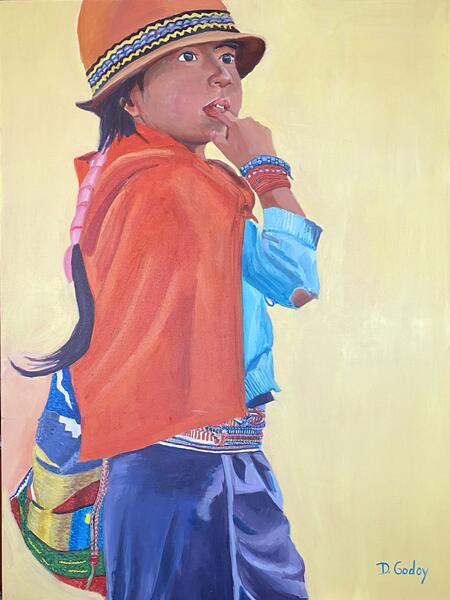 Indigenous girl out Exploring 2024 Acrylics on Canvas 30X 40
Indigenous girl out Exploring 2024 Acrylics on Canvas 30X 40I remember the day I took several pictures of this girl on our day in Santa Teresita. She seemed to be around six or seven but was ready to be a part of the filming day. She was strolling down the corner alone with her finger in her mouth. At first sight, I thought she had cut her finger by the way she is sucking one of them in this painting, but in another picture ( and painting) I could see her playing with the front gap one of her teeth had left. In this painting, I believe she was playing with another loose tooth.
This little girl always reminds me of how when I was a kid any outing no matter how big or small it was it always seemed like a huge adventure. She is wearing a traditional indigenous skirt wich is usually just a long vertical wrapped up cloth which is held up with “ fajas. Fajas are long thick hand woven belts /ribbons that has intricate colorful indigenous designs. She also has her skirt held up by colorfully braid coiled strings around her waist, Im guessing to ensure her skirt doesn’t fall down.
She is Also caring a “shigra” Which is a hand woven purses/ bags that traditionally both men women and children carry to transport their things. I remember my mother always had one when we lived in Ecuador. And even I had some back them. Then when we moved to the United States I often got gifted Shigras as a souvenir from Ecuador from family members who came to visit.
-
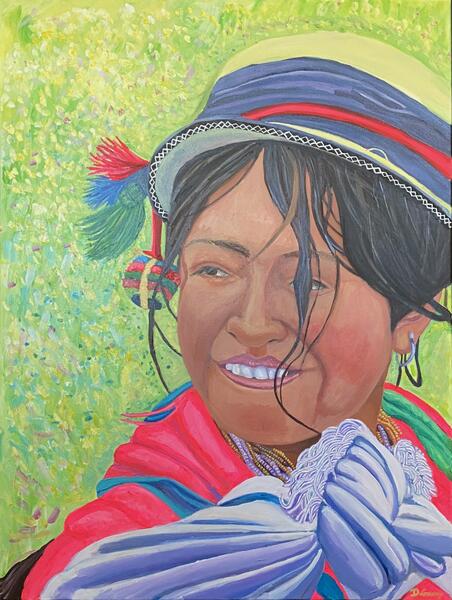 Blossoming, 30 X 40 Acrylics on canvas 2023
Blossoming, 30 X 40 Acrylics on canvas 2023I choose to name this painting entitled “Blossoming,” because its a painting of an Indigenous teenage girl with the traditional Puruah hat.
The Puruah women have this shyness that is so endearing, but at the same time makes them very difficult to photograph, because it is common for them to cover their faces or hide behind others. Which is why I treasure
all the hundreds of portraits I took of them , because it is very uncommon to be able to do so. And of course all the painting that have come as a result.
Upon reflecting on the theme of blossoming I concluded that we can blossom at different stages in our lives regardless of age. It more of a matter of seeking to put our effort into changing and growing as a result. Im grateful for all the changes Ive chosen to embark upon. -
 Wisdom, 2018.jpgWisdom. This painting entitled Wisdom is the first of the series because it embodies the wisdom that lies in the teaching of the indigenous people. This old lady also reminds me of my grandmother, and the fact that somehow, I’m trying to retrieve that history through these paintings. The guy with the audio recording device is doing just that recording his history as well. I didn’t have the privilege to get those stories from my grandma first hand because she passed when I was really young. However, I believe that these paintings help me share the colors that cultural history of that linage.
Wisdom, 2018.jpgWisdom. This painting entitled Wisdom is the first of the series because it embodies the wisdom that lies in the teaching of the indigenous people. This old lady also reminds me of my grandmother, and the fact that somehow, I’m trying to retrieve that history through these paintings. The guy with the audio recording device is doing just that recording his history as well. I didn’t have the privilege to get those stories from my grandma first hand because she passed when I was really young. However, I believe that these paintings help me share the colors that cultural history of that linage. -
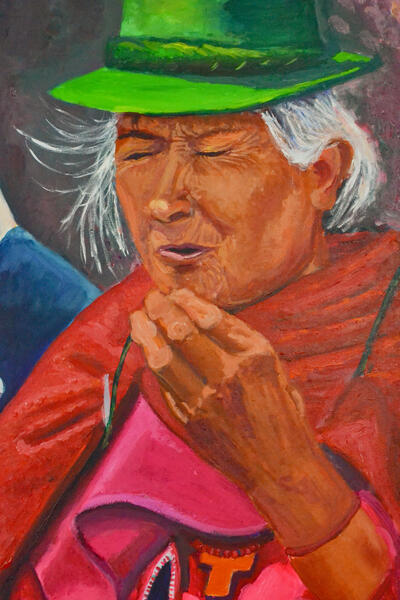 wisdom close up.jpgClose up of Wisdom the painting , 2018,
wisdom close up.jpgClose up of Wisdom the painting , 2018,
My Musical Family Legacy
Music always felt like breathing in my dad’s family. We come from a very long line of musicians, thanks to my grandfather, Luis Gonzalo Godoy’s heritage. My grandfather Luis Gonzalo Godoy’s is of the 4th generation of musicians, on his mother side and at least three generations on his dad's side. My dad and about half of his 9 brothers and sisters, play an instrument or sing, or both. My brother and most of my cousins play something or sing or both. I grew up with huge family gathering where live music was a normal way of life. I remember believing that everything my grandpa , my uncle Paco ( the one with most fame among my uncles and aunts) and my dad played was written by them. I was about four or five at the time, but I wasn’t completely off because my grandpa, uncle ,and my dad are the three most prominent composers of family. And all three have important compositions that are widely popular throughout Ecuador
Music has shaped me in more ways than one. Although I didn’t pursue a career in music. I could have if it hadn’t been for my stage fright. Growing up seeing the successful , musical careers my grandpa who had national and, internationally fame within the Latin American world always inspired me. He recently told me of his travels and how he played in Mexico, Colombia, Venezuela, Peru, etc. The financial stability my uncle Paco and my grandpa built with their music, gave me the confidence to believe that financial stability can be built around the pursuit of one’s passion. The impact my dad has made , with his research and writing and of course music, has instilled in me a sense of purpose that lies in our responsibility when it comes to sharing what we create with the world.
-
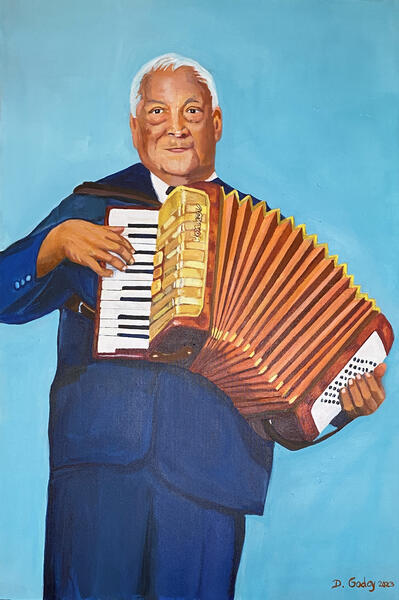 Portrait of Luis Gonzalo Godoy II ( for book covers) 2023
Portrait of Luis Gonzalo Godoy II ( for book covers) 2023Luis Gonzalo Godoy , my grandfather he was one of the first persons who showed me through his life that making a living doing what one loves is possible!He is now 93 years He has had a successful musical career, as a performer, recording artist & composer for 75 of those years! He is known in Ecuador as an artist that recorder with all of the greats in Ecuadors golden recording era. I was commissioned to do this portrait of him, for the book cover of a biography that was written about him 2023. I was also part of the translation team last year, which enabled the English translated version to be made 2024.
-
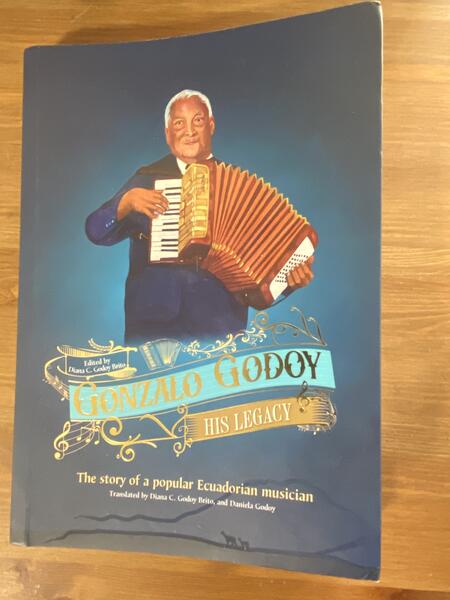 Gonzalo Godoy : His Legacy, The Story of an popular Ecuadorian Musician
Gonzalo Godoy : His Legacy, The Story of an popular Ecuadorian MusicianThis is The book cover with my portrait of my grandfather Luis Gonzalo Godoy I created in 2023. I also contributed in the translation of this book to English from ints original Spanish.
-
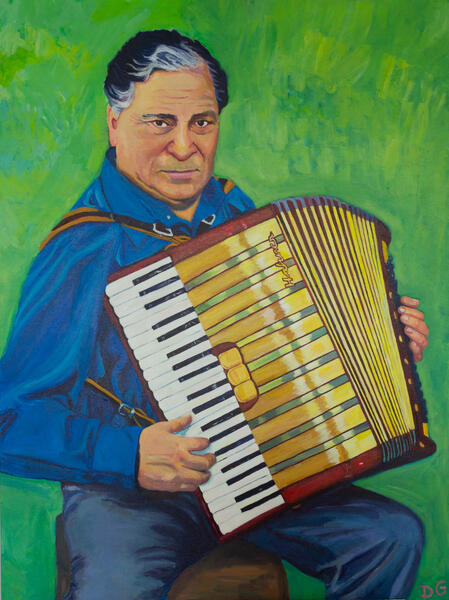 Mario Godoy Aguirre.jpgPortrait of Mario Godoy Aguirre. My dad is the firstborn of the 5th generation of musicians. He plays the accordion and the organ. He is also a composer, musicologist, historian, and writer. He has written many books on the history of Ecuadorian music, including musical textbooks. He help get October 1’s named the official Day of The Pasillo in honor of the celebrated Julio Jaramillo’s Birthday. In addition to making the proposal for the project that was presented to the UNESCO to get the Ecuadorian Pasillo named a Cultural Patrimony of Humanity, on Dec 15, 2021. He asked me to paint this for the back cover of one of his books in 2020. Over the years he has been very supportive of my career even as a kid. He even asked me to illustrate his album cover for the Christmas songs he recorded in 1997 when I was only 9.
Mario Godoy Aguirre.jpgPortrait of Mario Godoy Aguirre. My dad is the firstborn of the 5th generation of musicians. He plays the accordion and the organ. He is also a composer, musicologist, historian, and writer. He has written many books on the history of Ecuadorian music, including musical textbooks. He help get October 1’s named the official Day of The Pasillo in honor of the celebrated Julio Jaramillo’s Birthday. In addition to making the proposal for the project that was presented to the UNESCO to get the Ecuadorian Pasillo named a Cultural Patrimony of Humanity, on Dec 15, 2021. He asked me to paint this for the back cover of one of his books in 2020. Over the years he has been very supportive of my career even as a kid. He even asked me to illustrate his album cover for the Christmas songs he recorded in 1997 when I was only 9. -
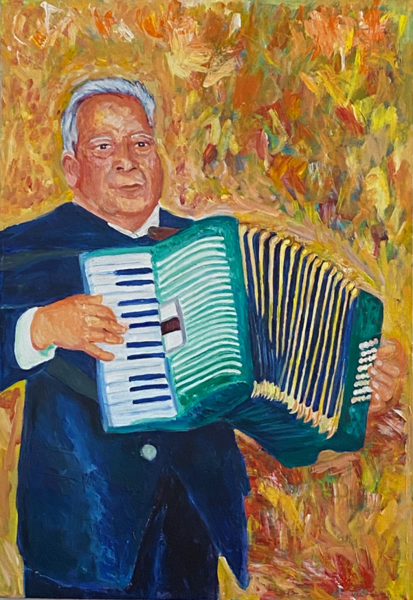 Portrait of Luis Gonzalo Godoy 2015
Portrait of Luis Gonzalo Godoy 2015Portrait of Luis Gonzalo Godoy. I come from a very only line of musicians, thanks to my grandfather, Luis Gonzalo Godoy’s heritage. He grew up with a single mother who later married my grandpa’s stepdad. In Ecuador, he worked as a maestro de Capilla,” Choirmaster,” up until before the pandemic. He is the first of four generations of musicians on his mom's side. There are at least three generations of musicians on his father’s side too. He tells how he would practically raise by his grandfather, Agustin Godoy Velarde. His mother and maternal aunts were church choir singers too. My grandpa tells how he started learning how to play the organ at 5 years old from watching his grandfather. And how he would soon fill in for his grandpa in mass when he couldn’t go. My Grandpa plays the accordion, the organ, the piano, and the guitar. At age 13 my grandpa left home to live on his own and traveled to Colombia, Venezuela, and other parts of Ecuador. Which is where he started playing and meeting musicians of different genres etc. In 1955 when he was a mere 23, he started recording in Guayaquil, Ecuador with his accordion with the big musicians in the Ecuadorian industry at that time. His signature sound marks some of Ecuador's classic golden era music in many different genres. He most notoriously is known for having recorded with Julio Jaramillo. Ecuador’s most internationally known singer. In addition to recording with Carlota Jaramillo, Duo Aguayo Guyamabe, etc. His musical heritage also comes from an extensive line of musicians on his dad Angel Serafin Pulgar, side too. My great-granddad was a part of at least two or three generations of musicians. Angel S. Pulgar was the orchestra director of the Military band named the “Galapagos Brigada, in Riobamba”. He played the trumpet and formed a regional brass band called “Angeles del inferno”( Hell’s Angels). My grandfather played in his dad’s band for a while too. My grandpa’s dad, and maternal grandfather, were also composers. My grandpa got married in 1954 and went on to have ten kids. Of the ten at least half have persuaded music professionally at some point in their lives, starting with my dad. My Mario G. Godoy, Antonio Godoy, Paco Godoy, Silvia Godoy, and Carmita Godoy play something or sing. Of my grandfather’s 20 grandkids, David, Alvaro, Gonzalo, Angie, Katherine, Adri, Ana Rosa, Lucy, Siboney, and Andres have studied music and most of them pursue music professionally too. Some of us like me, just sing at parties or karaoke. As I said music feels like breathing because I remember it since before birth. Maybe that’s one of the reasons so many of my paintings are from musically infused celebrations like the Jahuay, or the Pases del Niño ( Three kings Day impromptu parades). I've recently learned that I inherited more than my love of music from him. I inherited his love of traveling, his curiosity, and his commitment and passion to pursue his dreams, which I learned from his living example. He is currently 91 and he donated this portrait to the Museum of the Pasillo in Quito, Ecuador.
-
Portrait of David GodoyJPGPortrait of David Godoy Brito. This is a commission I did for my older brother David F. Godoy Brito. He is the firstborn of the sixth generation of musicians in the Godoy family legacy. He started playing the drums at age four. Around the age of 5-7, he sang several songs on an LP record of my dad’s made Children’s music compositions. My brother also dabbled with the xylophone and the recorder. In high school, he learned to play the clarinet, and later the Alto Saxophone. He has played in multiple ensembles, including a jazz ensemble at Montgomery College. He’s recently bought a Soprano Saxophone and is learning that too. What I admire about him is that he can pick up a song and start playing it on the spot, something that very few musicians I’ve known can do.
Colors & Textures of The Jahuay, Part 1 2012-2013
As my personal reaction to the fieldwork project I created “Colors & Textures of the Jahuay,” a twenty painting series exhibition, that represents the different key participants of the Jahuay, while chronologically narrating the different parts of the ritual. My paintings and photographs explore the humanistic, cultural aspects of the indigenous Andean people of Ecuador.. The fieldwork was completed in the summer of 2012. I have shown the Jahuay series in seven solo exhibitions from 2013 to 2015, six in Ecuador, and one in Hungary.
This series enabled me to learn first hand about my indigenous roots, since my maternal grandmother was of indigenous descent , of the Puruah people of this area. As such learning about this ritual gave me great insight into what my grandmother lived through during the time she was forced to work for one of the largest hacienda owners ( as a cook) of Chimborazo Province, where this song comes from. She died when I was only 12 and I barey got to know her. But seeing and hearing the songs ( which were later translatated to spanish), I got to learn invaluable knowledge about my heritage.
This portfolio is the first half of tht series
-
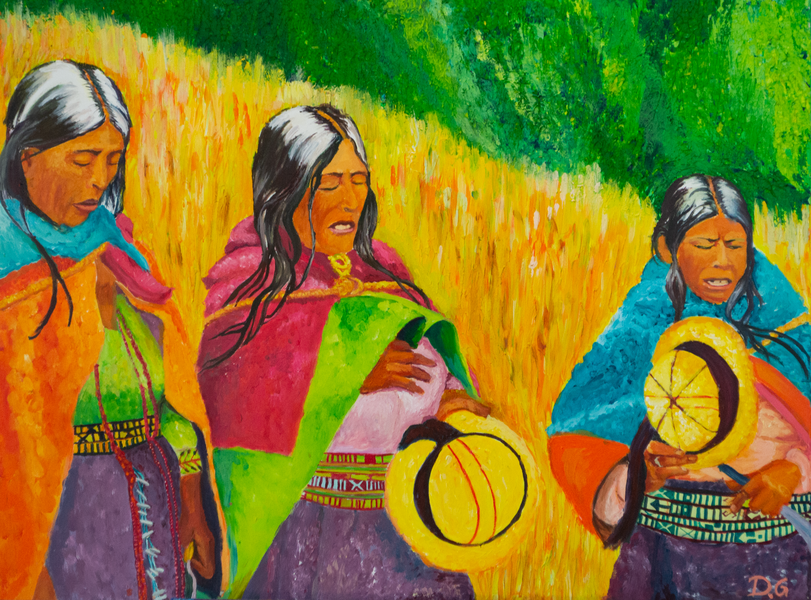 Rezo.Squarepace.pngRezo/ Jahuay Prayer,30X40', Acrylics with molding paste on canvas,8/1/2013. At the beginning of each harvest, the community starts out with prayers of gratitude to mother earth, the sun, the moon, and the mountains for a successful harvest. This painting also represents the theme of deep spiritual connection to the earth and the deities of some of the Jahuay songs.
Rezo.Squarepace.pngRezo/ Jahuay Prayer,30X40', Acrylics with molding paste on canvas,8/1/2013. At the beginning of each harvest, the community starts out with prayers of gratitude to mother earth, the sun, the moon, and the mountains for a successful harvest. This painting also represents the theme of deep spiritual connection to the earth and the deities of some of the Jahuay songs. -
 Boscinero.jpgBocinero/ Horn player, 19.5X23', Acrylics on Canvas, Sept 2012. The horn player is an important character within the harvest ritual, because he is the one that is responsible for calling the workers to the fields to commence the harvest, and his playing marks the start of each harvesting session.
Boscinero.jpgBocinero/ Horn player, 19.5X23', Acrylics on Canvas, Sept 2012. The horn player is an important character within the harvest ritual, because he is the one that is responsible for calling the workers to the fields to commence the harvest, and his playing marks the start of each harvesting session. -
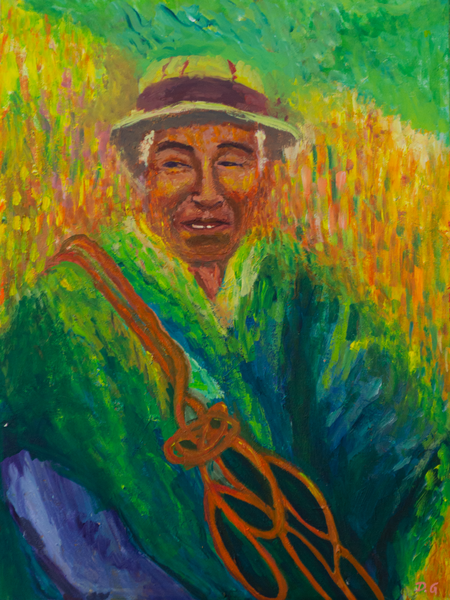 Paki.Squarepace.pngPaki, 30X40',Acrylics with molding paste on canvas,12/2012.The Paki is the solo singer of the Jahuay songs/genre. The Paki's transmitted through song the traditions, cosmology of the Puruah people. They told of the their the dieties and their day to day life. They also warned the community of abuses that certain member were suffering during from the land owners.At times the solo singer also told of the romances and deceptions within members. This tradition and knowledge was passed down from father to son, The maintaining their peoples knowledge for at least 500 years. Recently this has been in danger of disappearing, because of changes of agricultural advances, immigration, religion, etc.
Paki.Squarepace.pngPaki, 30X40',Acrylics with molding paste on canvas,12/2012.The Paki is the solo singer of the Jahuay songs/genre. The Paki's transmitted through song the traditions, cosmology of the Puruah people. They told of the their the dieties and their day to day life. They also warned the community of abuses that certain member were suffering during from the land owners.At times the solo singer also told of the romances and deceptions within members. This tradition and knowledge was passed down from father to son, The maintaining their peoples knowledge for at least 500 years. Recently this has been in danger of disappearing, because of changes of agricultural advances, immigration, religion, etc. -
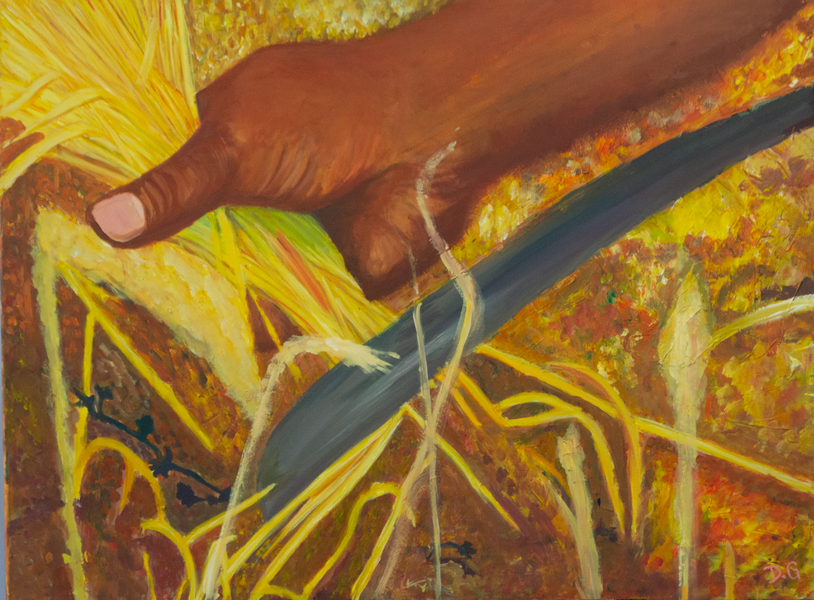 El Corte.Squarepace.pngEl Corte, The Cut, Depicts the first ceremonial cut of the harvest. It sets all the workers in motion and marks the start of the singing of the Jahuay.
El Corte.Squarepace.pngEl Corte, The Cut, Depicts the first ceremonial cut of the harvest. It sets all the workers in motion and marks the start of the singing of the Jahuay. -
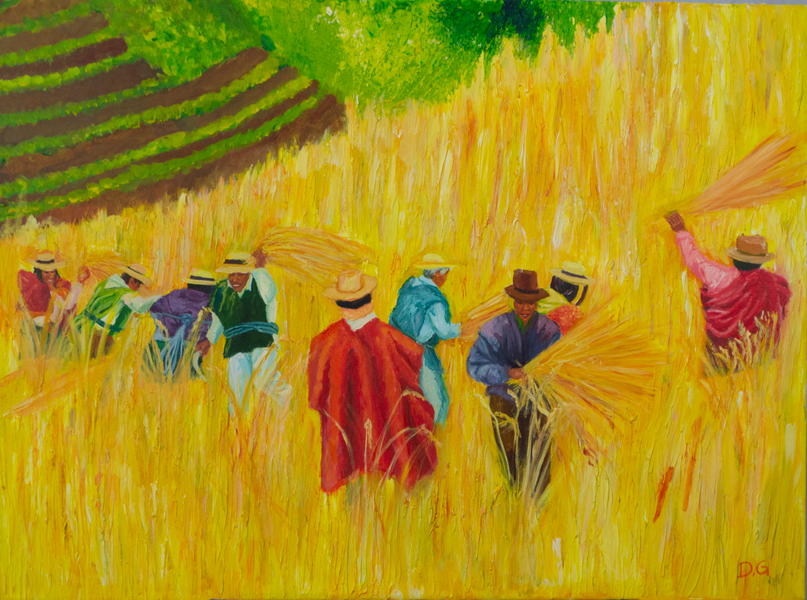 Cosechando juntos.Squarepace.pngCosechando Juntos/ Harvesting together. The celebratory sentiment of the Jahuay songs is shown through the textural of the paint application and the bright color pallet. Foreman is wearing a red colored poncho. This image shows how the workers are in constant movement, up and down the mountain, cutting and gathering the barley.
Cosechando juntos.Squarepace.pngCosechando Juntos/ Harvesting together. The celebratory sentiment of the Jahuay songs is shown through the textural of the paint application and the bright color pallet. Foreman is wearing a red colored poncho. This image shows how the workers are in constant movement, up and down the mountain, cutting and gathering the barley. -
 Cantoras de Jahuay/ Jahuay Singers..pngCantoras de Jahuay/ Jahuay Singers.The women’s voices are higher in pitch than the men’s voices, which serve to complement each other. Their Jahuay response to the Paki’s verses is both a celebratory chant of encouragement while at the same time the Jahuay response also the sound is sometimes daunting in its moaning quality. This painting was sold to the Museo de Pasillo (Museum of the Pasillo)in Quito Ecuador 2018, and is now a part of their permanent collection
Cantoras de Jahuay/ Jahuay Singers..pngCantoras de Jahuay/ Jahuay Singers.The women’s voices are higher in pitch than the men’s voices, which serve to complement each other. Their Jahuay response to the Paki’s verses is both a celebratory chant of encouragement while at the same time the Jahuay response also the sound is sometimes daunting in its moaning quality. This painting was sold to the Museo de Pasillo (Museum of the Pasillo)in Quito Ecuador 2018, and is now a part of their permanent collection -
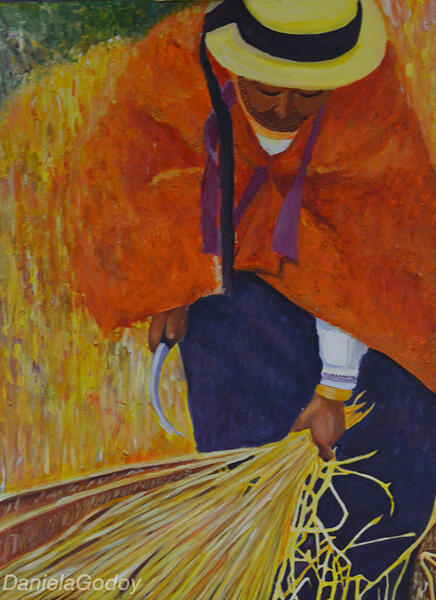 Cortando Cebada/ Cutting Barley..jpgCortando Cebada/ Cutting Barley. The Jahuay is unique in that, the songs often talk about the strong leadership and roles that women had in the indigenous communities. The Jahuay songs often told stories about their heroin to pass down lessons about fortitude and encouragement.
Cortando Cebada/ Cutting Barley..jpgCortando Cebada/ Cutting Barley. The Jahuay is unique in that, the songs often talk about the strong leadership and roles that women had in the indigenous communities. The Jahuay songs often told stories about their heroin to pass down lessons about fortitude and encouragement. -
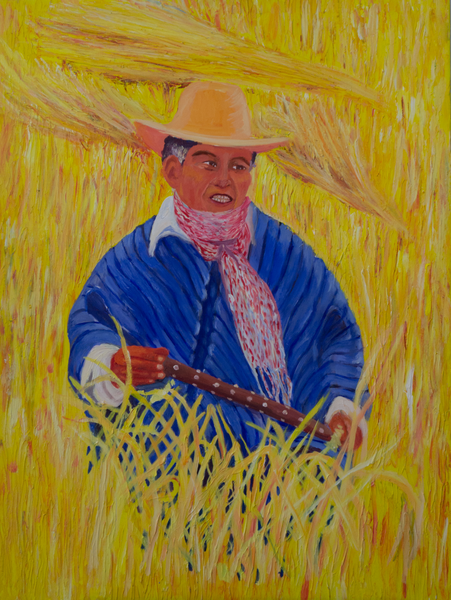 Mayordomo.Squarepace.pngMayordomo/Forman. The Forman was the one who was in charge of looking over the indigenous people working the land. He hold a whip because they were often known for whipping the workers if they were working fast enough etc. He was often very feared. Evens in the Jahuay song the Paki sometimes jeered the Mayordomo and the landowners, in the lyrics, and since the lyrics were all in Quichua the Mayordomo and the landowners didn't know what the songs said. The singing was often encouraged by the Forman because it kept the beat of the workers.
Mayordomo.Squarepace.pngMayordomo/Forman. The Forman was the one who was in charge of looking over the indigenous people working the land. He hold a whip because they were often known for whipping the workers if they were working fast enough etc. He was often very feared. Evens in the Jahuay song the Paki sometimes jeered the Mayordomo and the landowners, in the lyrics, and since the lyrics were all in Quichua the Mayordomo and the landowners didn't know what the songs said. The singing was often encouraged by the Forman because it kept the beat of the workers. -
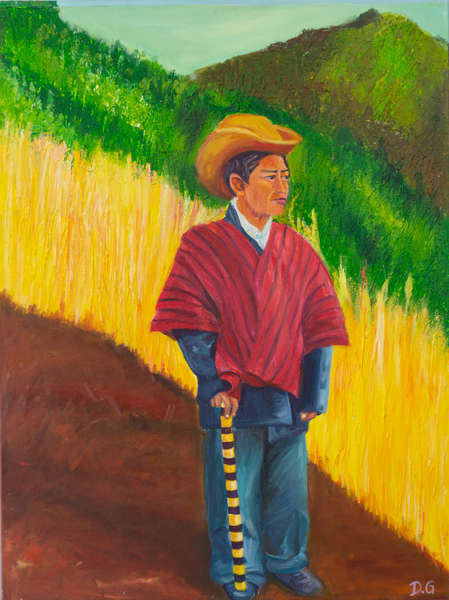 Hijo del Mayordomo/ The Foremen’s son.pngHijo del Mayordomo/ The Foremen’s son. The Foremen were hired to oversee the indigenous workers. He had the authority to whip them (with a cane or whip) if they were not working. The foreman’s son was to follow in his father’s footsteps. The Paki often sang Jahuay songs to mock the landowners & foremen, and foremen’s sons in Quichua.
Hijo del Mayordomo/ The Foremen’s son.pngHijo del Mayordomo/ The Foremen’s son. The Foremen were hired to oversee the indigenous workers. He had the authority to whip them (with a cane or whip) if they were not working. The foreman’s son was to follow in his father’s footsteps. The Paki often sang Jahuay songs to mock the landowners & foremen, and foremen’s sons in Quichua. -
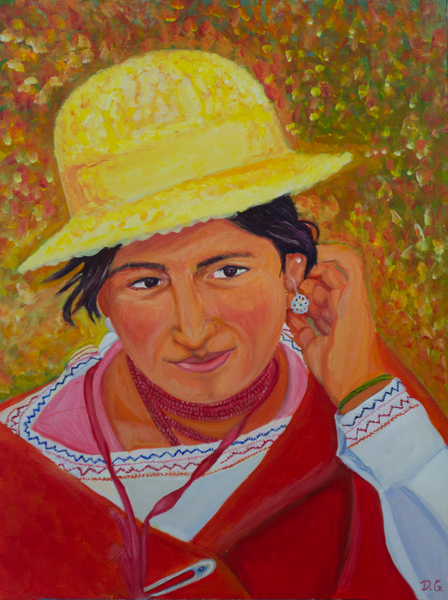 Coqueta/ Flirt.pngCoqueta/ Flirt. This is a painting of how the Jahuay often talks about the coming of age of women, of budding romances, and of the predominantly shy, character of the Andean women. Their subtly shy flirtation is often teased and mentioned in Jahuay songs.
Coqueta/ Flirt.pngCoqueta/ Flirt. This is a painting of how the Jahuay often talks about the coming of age of women, of budding romances, and of the predominantly shy, character of the Andean women. Their subtly shy flirtation is often teased and mentioned in Jahuay songs.
Colors & Textures of The Jahuay, Part 2 2012-2013
There is a loud stillness in the air, and the reverberating whistling memories of those summers submerge me into the past. The thin mountain air of the Ecuadorian Andes and the calling of the wind intone with, the primordial calling of the horn and the singing of harvest ritual song of the indigenous people. After graduating college I was hired to join a field research project sponsored by the Institute of Cultural Patrimony of Ecuador (a branch of the Ecuadorian government) as a photographer, painter and translator. Mario Godoy Aguirre was the creator, head historical researcher and musicologist, of this project. The project recovered and documented the ritual harvest songs of the Andean Indigenous communities of Chimborazo, Ecuador. These songs date back at least 500 years in Ecuadorian history and were in danger of disappearing.
As my personal reaction to the fieldwork project I created “Colors & Textures of the Jahuay,” a twenty painting series exhibition, that represents the different key participants of the Jahuay, while chronologically narrating the different parts of the ritual. My paintings and photographs explore the humanistic, cultural aspects of the indigenous Andean people of Ecuador.. The fieldwork was completed in the summer of 2012. I have shown the Jahuay series in seven solo exhibitions from 2013 to 2015, six in Ecuador, and one in Hungary.
This series enabled me to learn first hand about my indigenous roots, since my maternal grandmother was of indigenous descent , of the Puruah people of this area. As such learning about this ritual gave me great insight into what my grandmother lived through during the time she was forced to work for one of the largest hacienda owners ( as a cook) of Chimborazo Province, where this song comes from. She died when I was only 12 and I barey got to know her. But seeing and hearing the songs ( which were later translatated to spanish), I got to learn invaluable knowledge about my heritage.
This is the second half of this series.
-
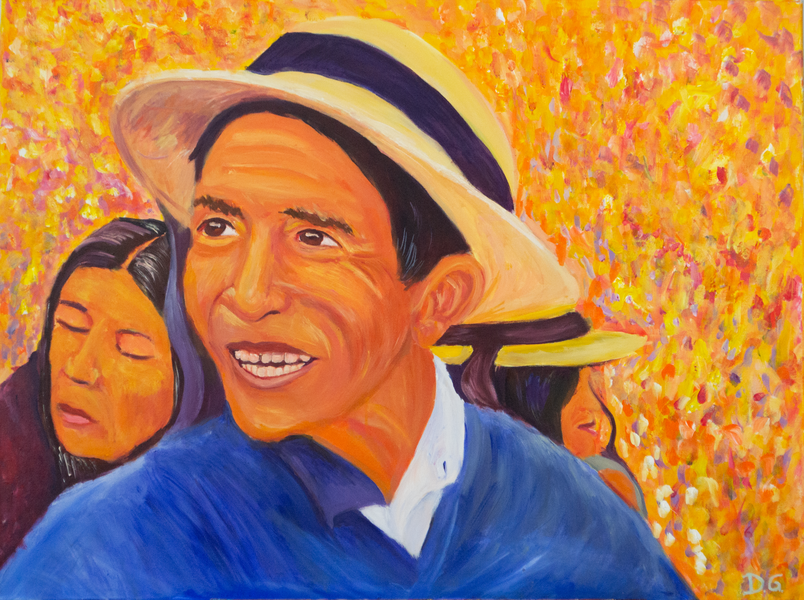 Tiangulo Triangle.pngTriangulo/ Triangle. Many of the Jahuay songs dealt with themes of romance and infidelity. I decided to incorporate this theme into my series after I found a picture that fit this idea of infidelity when I remembered the interaction between these three characters.
Tiangulo Triangle.pngTriangulo/ Triangle. Many of the Jahuay songs dealt with themes of romance and infidelity. I decided to incorporate this theme into my series after I found a picture that fit this idea of infidelity when I remembered the interaction between these three characters. -
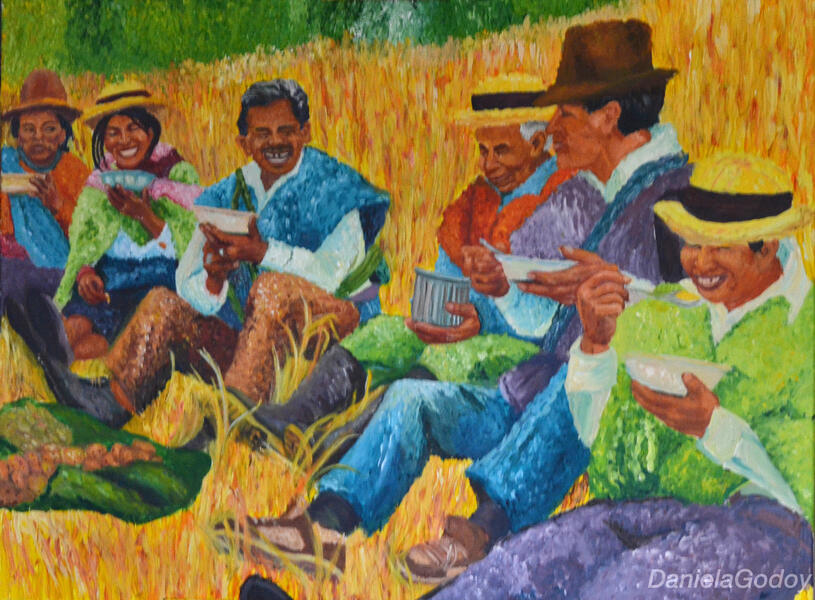 Almuerzo II, Lunch II.jpgAlmuerzo/ Lunch II. The pampa mesa represented in this painting is a symbol of Ecuadorian Andean generosity. Everyone that participated in the Jahuay harvest celebration knew how hard it was to feed their families with the little they got from the hacienda owners who would allow them. So Everone contributed some food to feed the rest of the community.
Almuerzo II, Lunch II.jpgAlmuerzo/ Lunch II. The pampa mesa represented in this painting is a symbol of Ecuadorian Andean generosity. Everyone that participated in the Jahuay harvest celebration knew how hard it was to feed their families with the little they got from the hacienda owners who would allow them. So Everone contributed some food to feed the rest of the community. -
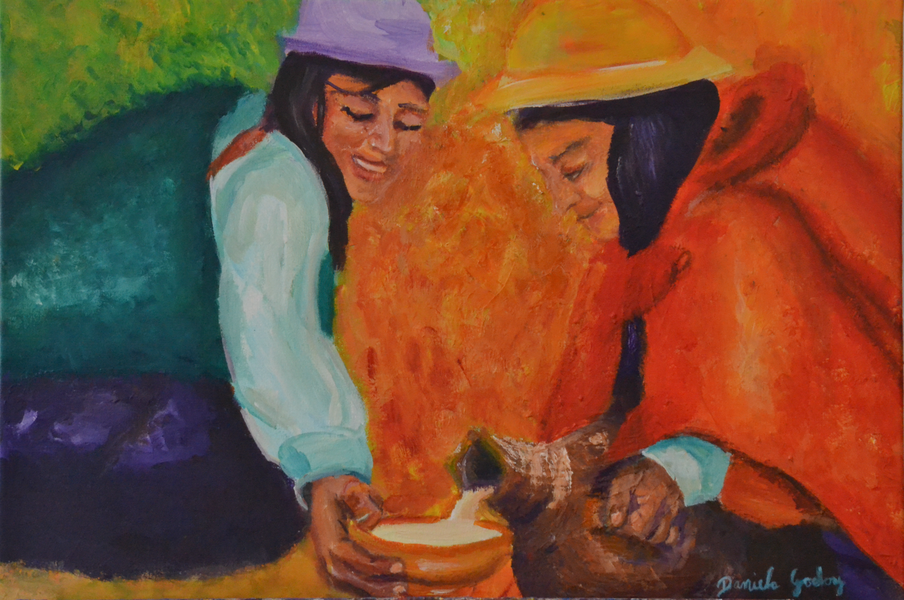 Solidaridad.Squarepace.png
Solidaridad.Squarepace.pngSolidaridad/ Solidarity.
In the Santa Teresita, community a few women brought big jugs of a hot barley beverage, which they shared with everyone including the research crew. This image personifies that community solidarity seen in times of the haciendas, they relayed the generosity & reciprocity their neighbors.
-
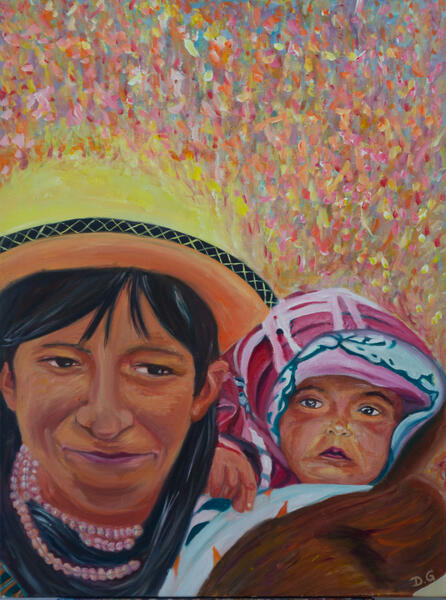 Mother and child.jpgMadre e Hija/ Mother daughter. This painting represents the innate protectiveness and the motherly role that women have within the community. The women feed and took care of their young while they were expected to work the same long hours in the field as the men. The women often shared responsibility with other women in the community to care for the children.
Mother and child.jpgMadre e Hija/ Mother daughter. This painting represents the innate protectiveness and the motherly role that women have within the community. The women feed and took care of their young while they were expected to work the same long hours in the field as the men. The women often shared responsibility with other women in the community to care for the children. -
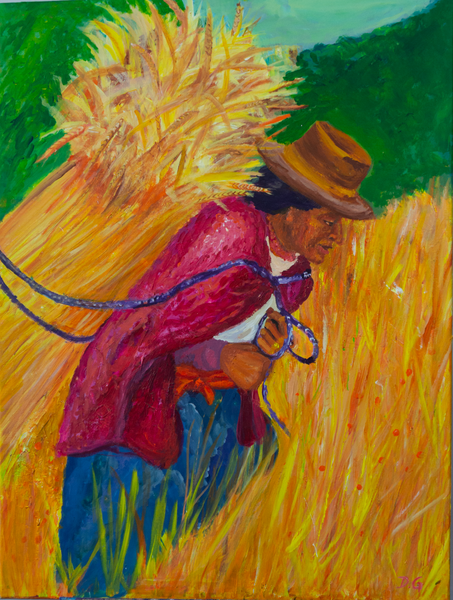 Cargadora/ Carrier.pngCargadora/ Carrier. In this painting, I wanted to represent how Indigenous Andean women are strong of will and physical strength. The women work with the men in near perpendicular mountain cutting, climbing, and carrying loads of barley while worrying about feeding everyone and taking care of their children.
Cargadora/ Carrier.pngCargadora/ Carrier. In this painting, I wanted to represent how Indigenous Andean women are strong of will and physical strength. The women work with the men in near perpendicular mountain cutting, climbing, and carrying loads of barley while worrying about feeding everyone and taking care of their children. -
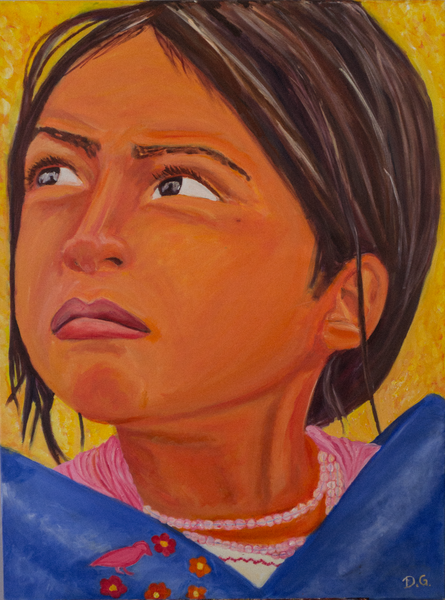 Ella es mi espejo/ She is my mirror..pngElla es mi espejo/ She is my mirror. After reviewing my images I noticed that there was a perfectly reflected silhouette of her mother in this girl's eyes. Much like the Jahuay songs are passed down from one generation, the older women pass down their generational knowledge to their young, thus becoming their mirrors.
Ella es mi espejo/ She is my mirror..pngElla es mi espejo/ She is my mirror. After reviewing my images I noticed that there was a perfectly reflected silhouette of her mother in this girl's eyes. Much like the Jahuay songs are passed down from one generation, the older women pass down their generational knowledge to their young, thus becoming their mirrors. -
 Cosechando.Squarepace.pngCosechando / Harvesting.This painting is very representative of the recurring style of paint application, for my Jahuay series, the small strokes of colors mimic the blurry sentiment of a memory, thus personifying the 500 years of history that the Jahuay songs embody. It also shows an intimate view of the workers. *This painting is currently part of a private collection in Connecticut
Cosechando.Squarepace.pngCosechando / Harvesting.This painting is very representative of the recurring style of paint application, for my Jahuay series, the small strokes of colors mimic the blurry sentiment of a memory, thus personifying the 500 years of history that the Jahuay songs embody. It also shows an intimate view of the workers. *This painting is currently part of a private collection in Connecticut -
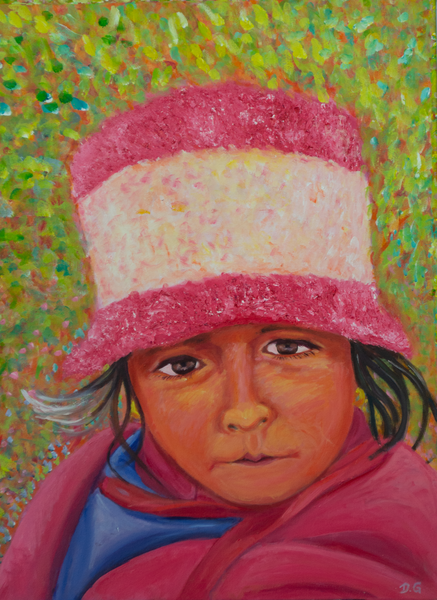 Curiosa/ Curious.pngCuriosa/ Curious. This girl represents the need for curiosity for knowledge about the Jahuay for present generations, in order to preserve it. The small-layered marks that create the background simulate the impermanence of time, while also representing the knowledge of the little girl’s forefathers.
Curiosa/ Curious.pngCuriosa/ Curious. This girl represents the need for curiosity for knowledge about the Jahuay for present generations, in order to preserve it. The small-layered marks that create the background simulate the impermanence of time, while also representing the knowledge of the little girl’s forefathers. -
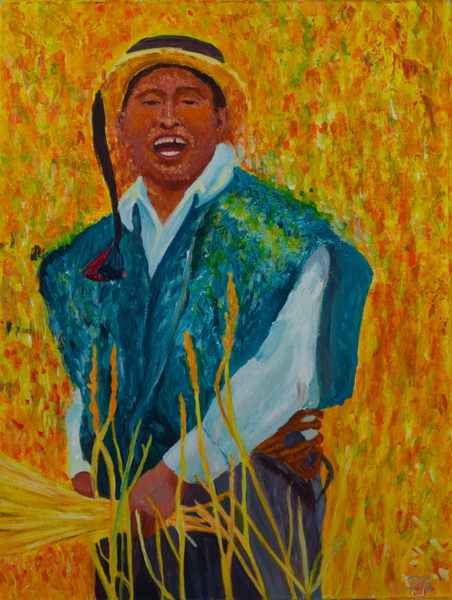 Cantor del Jahuay/ Jahuay Singer..pngCantor del Jahuay/ Jahuay Singer.The brightness of this painting is representative of, the singularly high-pitched voices of even the male Jahuay singers. He portrays the joyful celebratory sentiment the ritual has for the Ecuadorian Andean communities.
Cantor del Jahuay/ Jahuay Singer..pngCantor del Jahuay/ Jahuay Singer.The brightness of this painting is representative of, the singularly high-pitched voices of even the male Jahuay singers. He portrays the joyful celebratory sentiment the ritual has for the Ecuadorian Andean communities. -
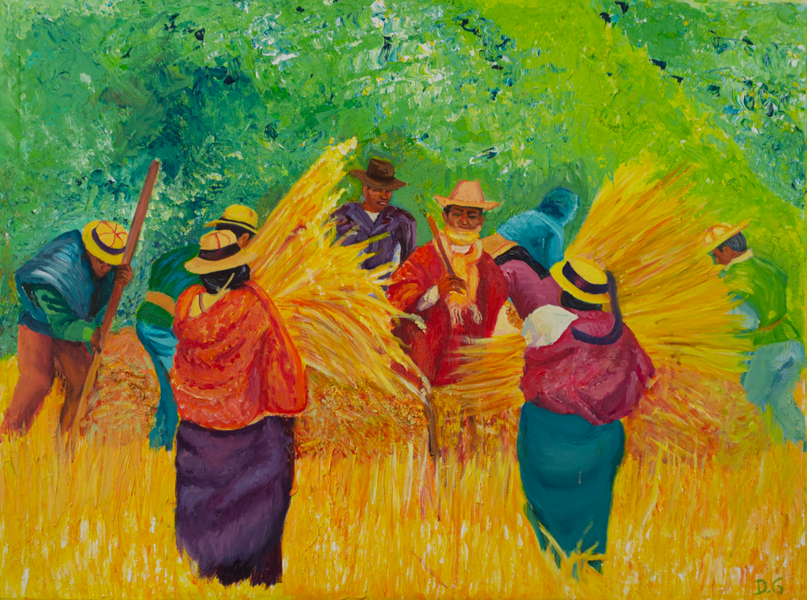 Construccion de Parva/ Parva Construction.pngConstruccion de Parva/ Parva Construction. At the end, of the harvest, the barley is carried & stored with the thistles facing the inner center of a circular structure called the Parva. Workers stand in the center to construct it. Paleros or men with flat wooden shovels stand outside checking that nothing sticks out.
Construccion de Parva/ Parva Construction.pngConstruccion de Parva/ Parva Construction. At the end, of the harvest, the barley is carried & stored with the thistles facing the inner center of a circular structure called the Parva. Workers stand in the center to construct it. Paleros or men with flat wooden shovels stand outside checking that nothing sticks out.
Portraits of the Puruah Indigenous people of Chimborazo, Ecuador Part I 2021
I seek to portray the faces of my ancestors, the indigenous people of the Chimborazo Province of Ecuador, also known as the Puruhá people, from which my maternal grandmother originated. These paintings came from candid photographs I took of different Puruhá communities in 2012. My bright color palette mirrors the bright clothing colors the Puruha are characterized by. Starting with the red ponchos specifically allude to the accessorial legacy of resistance and rebellions that the indigenous people were and are currently known for, while bright pinks and magentas are very characteristic of the women of the Puruhá people. Their bright colors are a testament to their history and mine.
I choose to represent the Puruhá people to connect with my grandmother's roots which she scarcely taught her children about it. Indigenous people in Ecuador and most parts of the world have been historically marginalized. My grandmother knew that and wanted to protect her children from it. She choose not to teach most of her children the Quichua language so they wouldn’t be discriminated against.
The Puruhá culture is rich in its colors and its unique knowledge passed down through oral tradition, like that of music. The Puruhá people are responsible for creating Jahuay (musical genre) harvest ritual song that dates back at least 500 years. I participated in a project which documented this. That project led to the images for my paintings in this series. These paintings are an homage to this group of people who are historically responsible for fighting the injustice of governments even to this day. The "Ponchos rojos"(red ponchos) uprisings helped eradicate the abuses that indigenous people suffered at the hands of colonizers and their decedents. The figures are alone because they are puzzle pieces of each other's communities. The puzzle pieces are also a metaphor for the artist's ancestry lineage, which is a mystery due to what little the family knows of her grandmother’s family. The subjects in the paintings become a part of the artist and the viewer who perceives them because they are no longer invisible. Our bonds to other humans remain broken when we ignore or refuse to preserve the common humanity and beauty that exist in those “different" from ourselves.
-
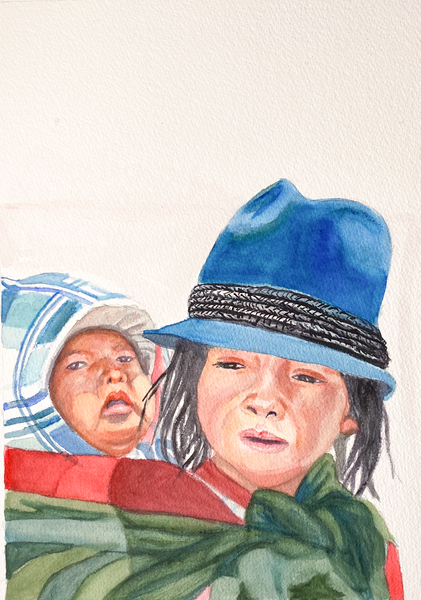 Young Indigenous Siblings..png
Young Indigenous Siblings..pngYoung Indigenous Siblings. Within the Indigenous community, it is very common to see young indigenous girls carrying their siblings on their backs to help their mothers. It’s a common tradition among indigenous descendants because that sense of community and helping out is deeply engrained into how their community work. Every time I’ve seen this, I wonder how she was doing it. Being that the older sister seemed no more than 10 years old and quite short ( which is common in Ecuador) and the baby seems very chubby. *This is currently at Harvard University Office of The Director of Arts Programs.
-
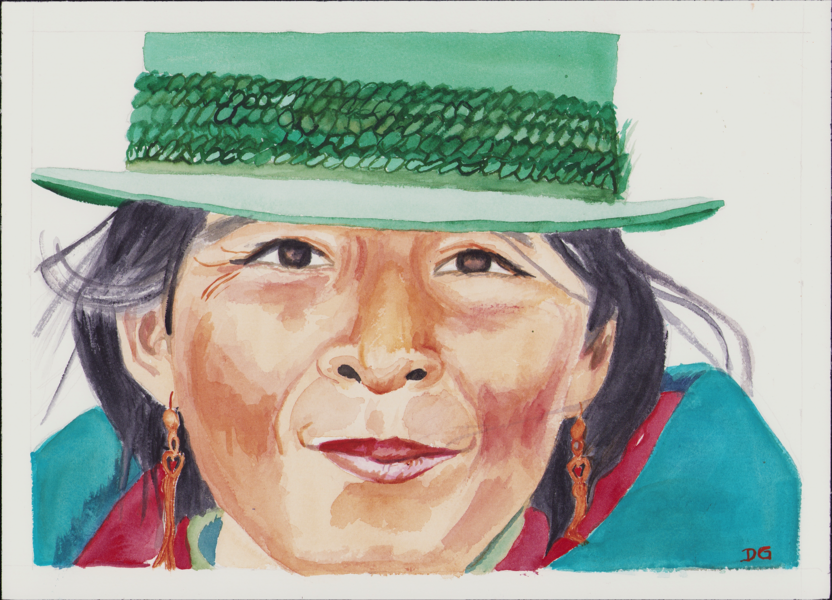 Portrait of a Indigenous woman with green hat, .pngPortrait of an Indigenous woman with a green hat. I scarcely remember taking this picture, but I decided to paint it because it’s rare to have indigenous people pose while looking directly at you. The women of this region are often very painfully shy and are often teased by locals for it. Yet this lady poses a sense of peace a grace that I’m glad I got to capture, both in this painting and the picture I took of her. *This is currently in a private collection in Maryland.
Portrait of a Indigenous woman with green hat, .pngPortrait of an Indigenous woman with a green hat. I scarcely remember taking this picture, but I decided to paint it because it’s rare to have indigenous people pose while looking directly at you. The women of this region are often very painfully shy and are often teased by locals for it. Yet this lady poses a sense of peace a grace that I’m glad I got to capture, both in this painting and the picture I took of her. *This is currently in a private collection in Maryland. -
 Portrait of young Indigenous man with blue coat .pngPortrait of a young Indigenous man with a blue coat. The indigenous youth, especially the young men boys, try to assimilate more into the mestizo Ecuadorians. He is not wearing the traditional Puruhá ponchos. While I think the global media may be contributing factor. I later noticed that one is less likely to see men wearing their traditional ponchos than women. etc. I’m guessing that it also has to do with the fact that the men are usually the ones that venture out away from their rural country communities into the neighboring city of Riobamba. Their pursuit of jobs forces them to assimilate in the way they dress to not be immediately discriminated against when they are seeking jobs.
Portrait of young Indigenous man with blue coat .pngPortrait of a young Indigenous man with a blue coat. The indigenous youth, especially the young men boys, try to assimilate more into the mestizo Ecuadorians. He is not wearing the traditional Puruhá ponchos. While I think the global media may be contributing factor. I later noticed that one is less likely to see men wearing their traditional ponchos than women. etc. I’m guessing that it also has to do with the fact that the men are usually the ones that venture out away from their rural country communities into the neighboring city of Riobamba. Their pursuit of jobs forces them to assimilate in the way they dress to not be immediately discriminated against when they are seeking jobs. -
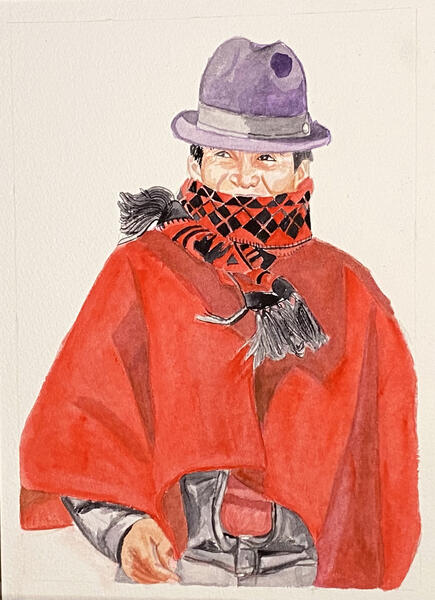 Sr. wearing Red Poncho,.jpgSr. wearing Red Poncho. The Puruhá people are known as the “Ponchos Rojos” in Ecuador. The Ponchos rojos became a symbol of revolution and rebellion because they lead the revolts that overturned the colonizers and their descendants to reclaim their lands and crops. As such this red poncho is emblematic, of the Puruhá ideals. The Puruhá people continue to lead mass protests nationally to uphold and defend workers’ rights even to this day. *This is currently in a private collection in Maryland.
Sr. wearing Red Poncho,.jpgSr. wearing Red Poncho. The Puruhá people are known as the “Ponchos Rojos” in Ecuador. The Ponchos rojos became a symbol of revolution and rebellion because they lead the revolts that overturned the colonizers and their descendants to reclaim their lands and crops. As such this red poncho is emblematic, of the Puruhá ideals. The Puruhá people continue to lead mass protests nationally to uphold and defend workers’ rights even to this day. *This is currently in a private collection in Maryland. -
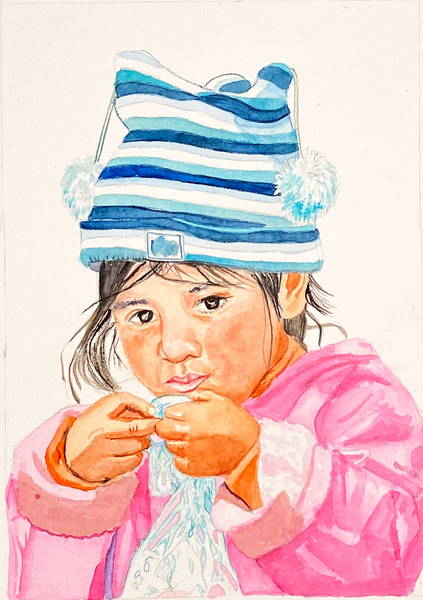 Little girl eating out of mysterious plastic..pngLittle girl eating out of mysterious plastic. The picture I took of this little girl eating something mysterious out of a plastic bag brought me so many memories of my first seven years of life in Ecuador. It’s common to buy street food from vendors and to have it handed in a plastic bag, including drinks. While my mom wasn’t keen on buying us food from street vendors often. I remember the few times it because sort of a fond indulgence whenever we did get to eat something from a street vendor.
Little girl eating out of mysterious plastic..pngLittle girl eating out of mysterious plastic. The picture I took of this little girl eating something mysterious out of a plastic bag brought me so many memories of my first seven years of life in Ecuador. It’s common to buy street food from vendors and to have it handed in a plastic bag, including drinks. While my mom wasn’t keen on buying us food from street vendors often. I remember the few times it because sort of a fond indulgence whenever we did get to eat something from a street vendor. -
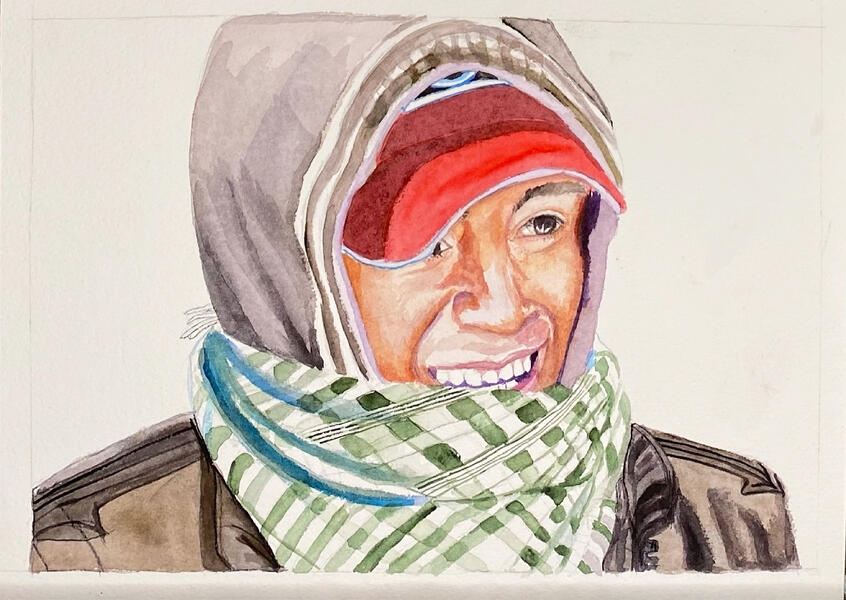 Young man wearing red hat.jpgYoung man wearing a red sports hat. Here is another example of a young man wearing mestizo clothing. While a quick view, may not say much. The fact that he is wearing his sports hat under his hoody and he has a scarf wrapped around his hooded neck shows he has ample knowledge of the frigid windy temperatures of Cocán, in the province of Chimborazo. Something which was news to this mestiza ( Mestizo/a term used to refer to someone of indigenous and Spaniard descendants) photographer who suffered greatly for not taking my uncle seriously when he told me to bundle up.
Young man wearing red hat.jpgYoung man wearing a red sports hat. Here is another example of a young man wearing mestizo clothing. While a quick view, may not say much. The fact that he is wearing his sports hat under his hoody and he has a scarf wrapped around his hooded neck shows he has ample knowledge of the frigid windy temperatures of Cocán, in the province of Chimborazo. Something which was news to this mestiza ( Mestizo/a term used to refer to someone of indigenous and Spaniard descendants) photographer who suffered greatly for not taking my uncle seriously when he told me to bundle up. -
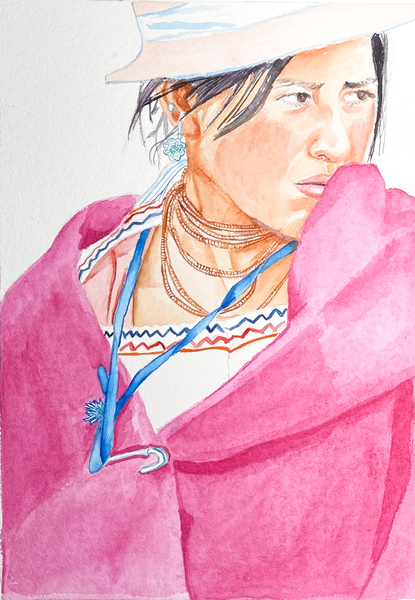 Young Indigenous woman in Pink..pngYoung Indigenous woman in Pink. The embroidered blouse, with a wrapped necklace multiple times, and the earrings exude the femineity of the indigenous women of Chimborazo. There is scarcely a time where you will ever see any of the women, young girls, or older women not wearing jewelry of some sort. This painting and her pose always remind me of the subtle filtration that the indigenous women exude in a nonchalant manner. *This is currently in a private collection in Tbilisi, Georgia.
Young Indigenous woman in Pink..pngYoung Indigenous woman in Pink. The embroidered blouse, with a wrapped necklace multiple times, and the earrings exude the femineity of the indigenous women of Chimborazo. There is scarcely a time where you will ever see any of the women, young girls, or older women not wearing jewelry of some sort. This painting and her pose always remind me of the subtle filtration that the indigenous women exude in a nonchalant manner. *This is currently in a private collection in Tbilisi, Georgia. -
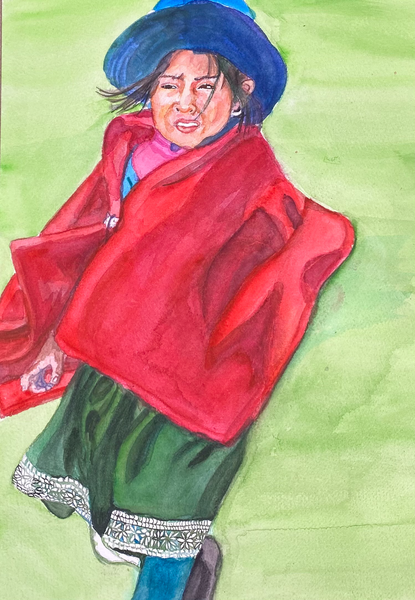 .pngGirl in Red Poncho. There is a very rude derogatory local saying used that basically says that people who dress in red and green are indigenous. And to be seen in public wearing a red and green outfit will get you lots of looks and people pointing. I had to come here and grow up seeing a whole much of Christmassy outfits in red and green to truly see how prejudiced and insane that saying is. This little girl is frolicking on a windy day wearing red and green exudes a sense of freedom and carefree nature I so admire in kids. * This is currently in a private collection in Transylvania, Romania
.pngGirl in Red Poncho. There is a very rude derogatory local saying used that basically says that people who dress in red and green are indigenous. And to be seen in public wearing a red and green outfit will get you lots of looks and people pointing. I had to come here and grow up seeing a whole much of Christmassy outfits in red and green to truly see how prejudiced and insane that saying is. This little girl is frolicking on a windy day wearing red and green exudes a sense of freedom and carefree nature I so admire in kids. * This is currently in a private collection in Transylvania, Romania
Portraits of the Puruah Indigenous people of Chimborazo, Ecuador Part II 2021
I choose to represent the Puruhá people to connect with my grandmother's roots which she scarcely taught her children about it. Indigenous people in Ecuador and most parts of the world have been historically marginalized. My grandmother knew that and wanted to protect her children from it. She choose not to teach most of her children the Quichua language so they wouldn’t be discriminated against.
The Puruhá culture is rich in its colors and its unique knowledge passed down through oral tradition, like that of music. The Puruhá people are responsible for creating Jahuay (musical genre) harvest ritual song that dates back at least 500 years. I participated in a project which documented this. That project led to the images for my paintings in this series. These paintings are an homage to this group of people who are historically responsible for fighting the injustice of governments even to this day. The "Ponchos rojos"(red ponchos) uprisings helped eradicate the abuses that indigenous people suffered at the hands of colonizers and their decedents. The figures are alone because they are puzzle pieces of each other's communities. The puzzle pieces are also a metaphor for the artist's ancestry lineage, which is a mystery due to what little the family knows of her grandmother’s family. The subjects in the paintings become a part of the artist and the viewer who perceives them because they are no longer invisible. Our bonds to other humans remain broken when we ignore or refuse to preserve the common humanity and beauty that exist in those “different" from ourselves.
-
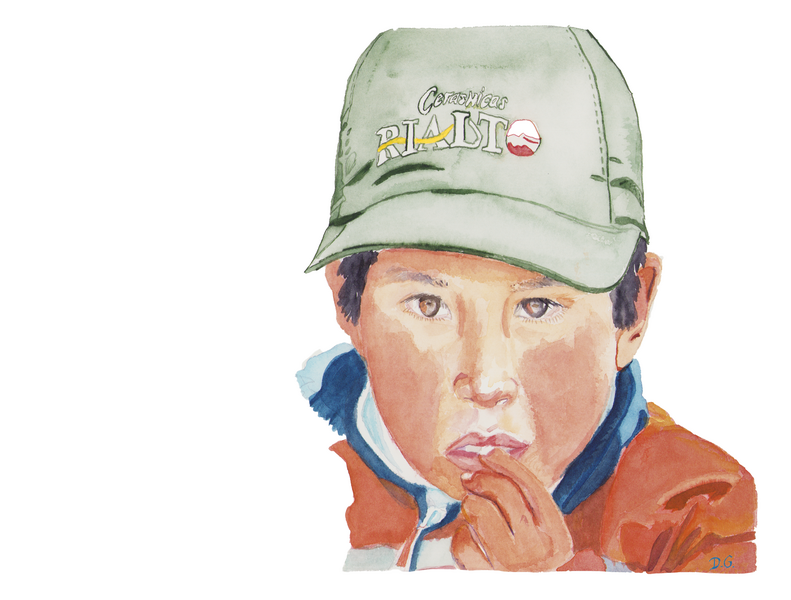 Curious young boy .pngCurious young boy, This portrait is of an indigenous boy who caught my eye. He had been tearing up asking his mother for something. I caught the moment after he calmed down with my camera in this painting. It's culturally common for entire indigenous families to attend big community celebrations. I assume that it’s because otherwise the kids would be left alone if the entire communities are out. I took this at a Jahuay festival ( recreation of the January songs competition), in Cocán. I felt the little boy’s angst, he was probably bored and cold.
Curious young boy .pngCurious young boy, This portrait is of an indigenous boy who caught my eye. He had been tearing up asking his mother for something. I caught the moment after he calmed down with my camera in this painting. It's culturally common for entire indigenous families to attend big community celebrations. I assume that it’s because otherwise the kids would be left alone if the entire communities are out. I took this at a Jahuay festival ( recreation of the January songs competition), in Cocán. I felt the little boy’s angst, he was probably bored and cold. -
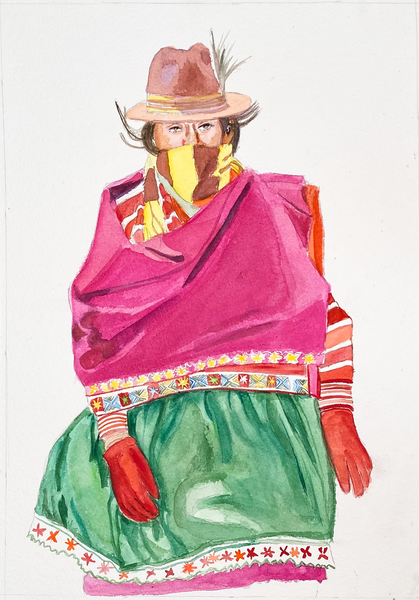 Ecuadorian Indigenous Woman on a Cold Day.pngEcuadorian Indigenous Woman on a Cold Day. I remember taking the picture of this indigenous woman in Cocán, Chimborazo Province of Ecuador. While I always keep to the colors the Puruhá people are known for using. I sometimes alter a few colors from the pictures to help the people stand out more, but in this particular, I painted the colors of her clothing exactly how she wore them from head to toe. She exemplifies the bright exuberance of the Puruhá women that I loved seeing as a child when I traveled to visit my grandmother in Riobamba. *This is currently in a private collection in Connecticut.
Ecuadorian Indigenous Woman on a Cold Day.pngEcuadorian Indigenous Woman on a Cold Day. I remember taking the picture of this indigenous woman in Cocán, Chimborazo Province of Ecuador. While I always keep to the colors the Puruhá people are known for using. I sometimes alter a few colors from the pictures to help the people stand out more, but in this particular, I painted the colors of her clothing exactly how she wore them from head to toe. She exemplifies the bright exuberance of the Puruhá women that I loved seeing as a child when I traveled to visit my grandmother in Riobamba. *This is currently in a private collection in Connecticut. -
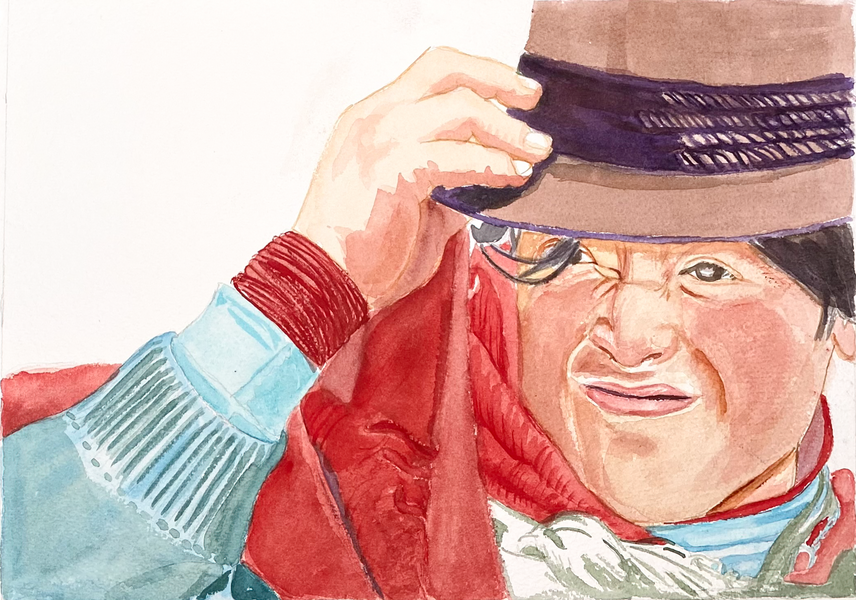 Indigenous Lady on a Sunny Day.pngIndigenous Lady on a Sunny Day. People often ask me, why the people in my paintings are so covered up with what appears to be thick clothing if this is themed around Ecuador, a South American country. The Chimborazo Province in Ecuador has an elevation of 20,549.4 ft). The summit of Chimborazo is the point on the Earth's surface that is farthest from the Earth's center. These high elevations make it very cold and windy in this province, in comparison to other areas of Ecuador. The sun hits directly midday and this lady’s facial expression reminds me of the face many of us make on those sunny days, in which you can get sunburned even if it's cloudy.
Indigenous Lady on a Sunny Day.pngIndigenous Lady on a Sunny Day. People often ask me, why the people in my paintings are so covered up with what appears to be thick clothing if this is themed around Ecuador, a South American country. The Chimborazo Province in Ecuador has an elevation of 20,549.4 ft). The summit of Chimborazo is the point on the Earth's surface that is farthest from the Earth's center. These high elevations make it very cold and windy in this province, in comparison to other areas of Ecuador. The sun hits directly midday and this lady’s facial expression reminds me of the face many of us make on those sunny days, in which you can get sunburned even if it's cloudy. -
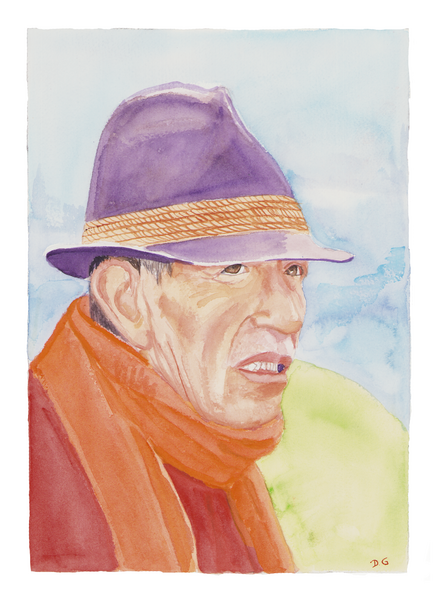 Elderly Indigenous Man.pngElderly Indigenous Man. This portrait always reminds me of my uncle Juan my mom’s eldest brother because this man looks very much like him. My uncle was born close to the Galtes hacienda, where my grandmother grew up and worked. He was one of the few of my uncles and aunt who learned the Quichua language. The man in this portrait however I believe was a substitute Paki if I remember correctly, for one of our recording days of the Jahuay research project. He was one of the few older men I choose to portray maybe because of his likeness to my uncle.
Elderly Indigenous Man.pngElderly Indigenous Man. This portrait always reminds me of my uncle Juan my mom’s eldest brother because this man looks very much like him. My uncle was born close to the Galtes hacienda, where my grandmother grew up and worked. He was one of the few of my uncles and aunt who learned the Quichua language. The man in this portrait however I believe was a substitute Paki if I remember correctly, for one of our recording days of the Jahuay research project. He was one of the few older men I choose to portray maybe because of his likeness to my uncle. -
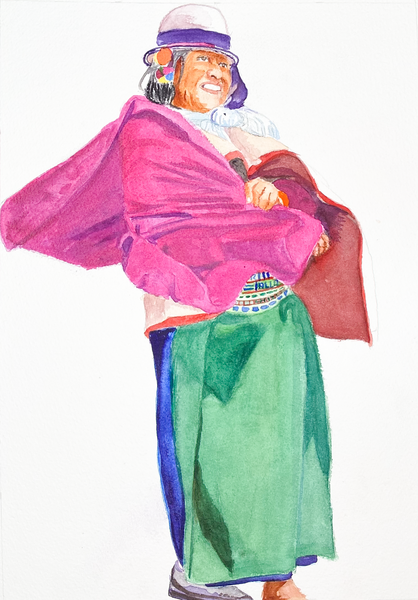 Indigenous Woman in Bright Fuschia..pngIndigenous Woman in Bright Fuschia. This painting is of an elderly indigenous woman, who I took a picture of mid-motion taking off one of her rebozos( thick shawls )Which always reminds me of a superheroine taking off her cape. The bright colors are exactly as she wore them. It wasn’t until I moved to the United States that I started to notice that there is a scarcely bright color available for older women usually past their twenties. I find it interesting because for the Puruhá women and men, colorful attire is not limited to an age group, it just is, part of their identity.
Indigenous Woman in Bright Fuschia..pngIndigenous Woman in Bright Fuschia. This painting is of an elderly indigenous woman, who I took a picture of mid-motion taking off one of her rebozos( thick shawls )Which always reminds me of a superheroine taking off her cape. The bright colors are exactly as she wore them. It wasn’t until I moved to the United States that I started to notice that there is a scarcely bright color available for older women usually past their twenties. I find it interesting because for the Puruhá women and men, colorful attire is not limited to an age group, it just is, part of their identity. -
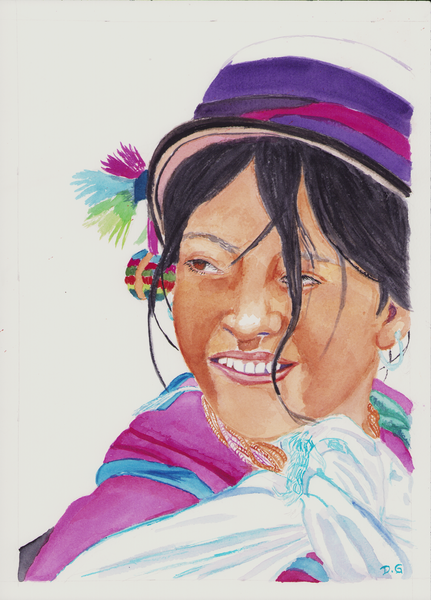 Girl with Traditional hat of Indigenous Women of the Province of Chimborazo Ecuador.pngGirl with Traditional hat of Indigenous Women of the Province of Chimborazo Ecuador. I made it a point to address the fact that this girl is wearing the traditional indigenous felt hat of the Puruhá women. It includes colored ribbons and round bright colored ball tassels. The hair that falls on her face almost seems intentional. This reminds me of how subtitle flirting happened among the community, with the way the young girls her age “ dress up a bit more starting at that age. This girl was probably between 13 and 15 years old. *This is currently in a private collection in Connecticut.
Girl with Traditional hat of Indigenous Women of the Province of Chimborazo Ecuador.pngGirl with Traditional hat of Indigenous Women of the Province of Chimborazo Ecuador. I made it a point to address the fact that this girl is wearing the traditional indigenous felt hat of the Puruhá women. It includes colored ribbons and round bright colored ball tassels. The hair that falls on her face almost seems intentional. This reminds me of how subtitle flirting happened among the community, with the way the young girls her age “ dress up a bit more starting at that age. This girl was probably between 13 and 15 years old. *This is currently in a private collection in Connecticut. -
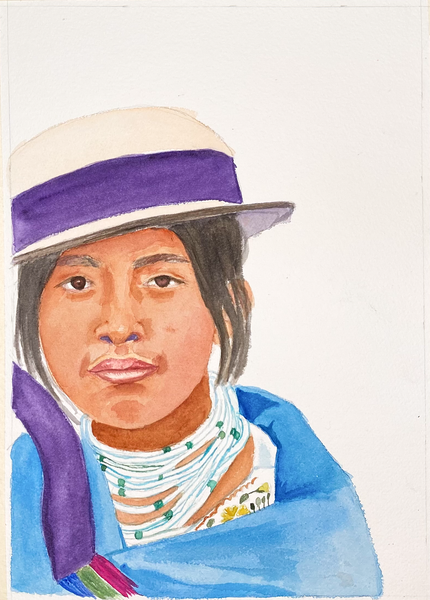 Girl in the Blue rebozo.pngGirl in the Blue Rebozo. I found a bored seriousness in this girl, and I decided to paint her precisely for that reason. As I mentioned before, entire families often attend big important community events with their parents. Which I guess can be really boring for kids. I really enjoyed the high contrast that her skin has with her blue rebozo.
Girl in the Blue rebozo.pngGirl in the Blue Rebozo. I found a bored seriousness in this girl, and I decided to paint her precisely for that reason. As I mentioned before, entire families often attend big important community events with their parents. Which I guess can be really boring for kids. I really enjoyed the high contrast that her skin has with her blue rebozo. -
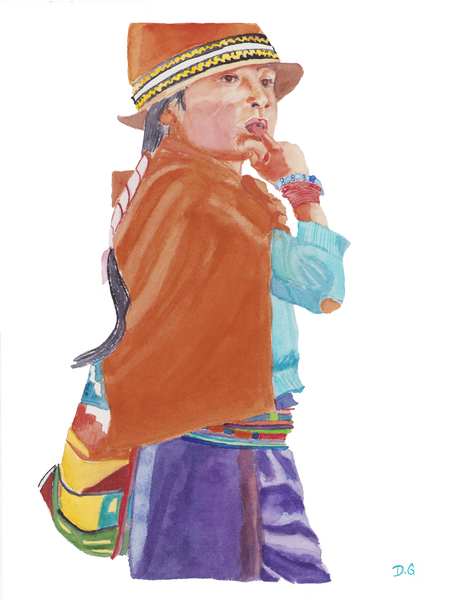 Indigenous Girl out Exploring .pngIndigenous Girl out Exploring. I remember taking the day I took several pictures of this girl on our day in Santa Teresita. She sheened to be around six or seven but was ready to be a part of the filming day. She was strolling down the corner alone with her finger in her mouth. At first sight, I thought she had cut her finger by the way she is sucking one of them in this painting, but in another picture ( and painting) I could see her playing with the front gap one of her teeth had left. In this painting, I believe she was playing with another loose tooth. I was drawn to her remarkable character to be so young and ready to explore her surroundings.
Indigenous Girl out Exploring .pngIndigenous Girl out Exploring. I remember taking the day I took several pictures of this girl on our day in Santa Teresita. She sheened to be around six or seven but was ready to be a part of the filming day. She was strolling down the corner alone with her finger in her mouth. At first sight, I thought she had cut her finger by the way she is sucking one of them in this painting, but in another picture ( and painting) I could see her playing with the front gap one of her teeth had left. In this painting, I believe she was playing with another loose tooth. I was drawn to her remarkable character to be so young and ready to explore her surroundings. -
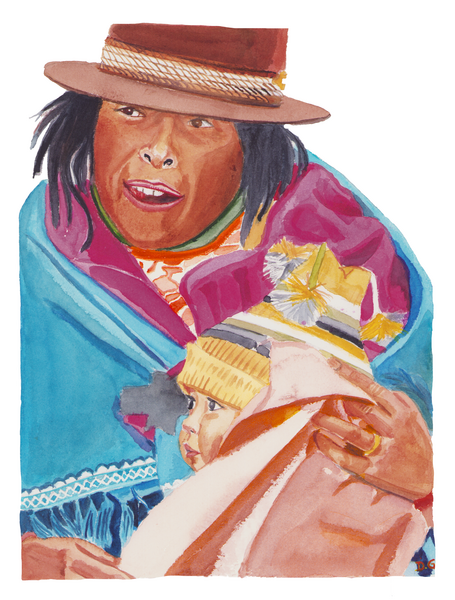 Grandmother bitting tongue holding grandson.pngGrandmother bitting tongue holding grandson. This portrait always reminds me of me and my maternal grandmother. As I’ve stated before she was of this indigenous community. And I imagine her wearing and taking care of her kids and grandkids much like this lady is doing. I didn’t get to know her very much since she passed when I was 12. I didn’t live in the same city as her for most of the seven years I lived in Ecuador. And I remember she was very sick toward the end so I don’t remember much about her. My mom has told me though that she made baby blankets and sheets for my siblings and me.
Grandmother bitting tongue holding grandson.pngGrandmother bitting tongue holding grandson. This portrait always reminds me of me and my maternal grandmother. As I’ve stated before she was of this indigenous community. And I imagine her wearing and taking care of her kids and grandkids much like this lady is doing. I didn’t get to know her very much since she passed when I was 12. I didn’t live in the same city as her for most of the seven years I lived in Ecuador. And I remember she was very sick toward the end so I don’t remember much about her. My mom has told me though that she made baby blankets and sheets for my siblings and me.
Portraits of the Puruah Indigenous people of Chimborazo, Ecuador Part III 2021
I choose to represent the Puruhá people to connect with my grandmother's roots which she scarcely taught her children about it. Indigenous people in Ecuador and most parts of the world have been historically marginalized. My grandmother knew that and wanted to protect her children from it. She choose not to teach most of her children the Quichua language so they wouldn’t be discriminated against.
The Puruhá culture is rich in its colors and its unique knowledge passed down through oral tradition, like that of music. The Puruhá people are responsible for creating Jahuay (musical genre) harvest ritual song that dates back at least 500 years. I participated in a project which documented this. That project led to the images for my paintings in this series. These paintings are an homage to this group of people who are historically responsible for fighting the injustice of governments even to this day. The "Ponchos rojos"(red ponchos) uprisings helped eradicate the abuses that indigenous people suffered at the hands of colonizers and their decedents. The figures are alone because they are puzzle pieces of each other's communities. The puzzle pieces are also a metaphor for the artist's ancestry lineage, which is a mystery due to what little the family knows of her grandmother’s family. The subjects in the paintings become a part of the artist and the viewer who perceives them because they are no longer invisible. Our bonds to other humans remain broken when we ignore or refuse to preserve the common humanity and beauty that exist in those “different" from ourselves.
-
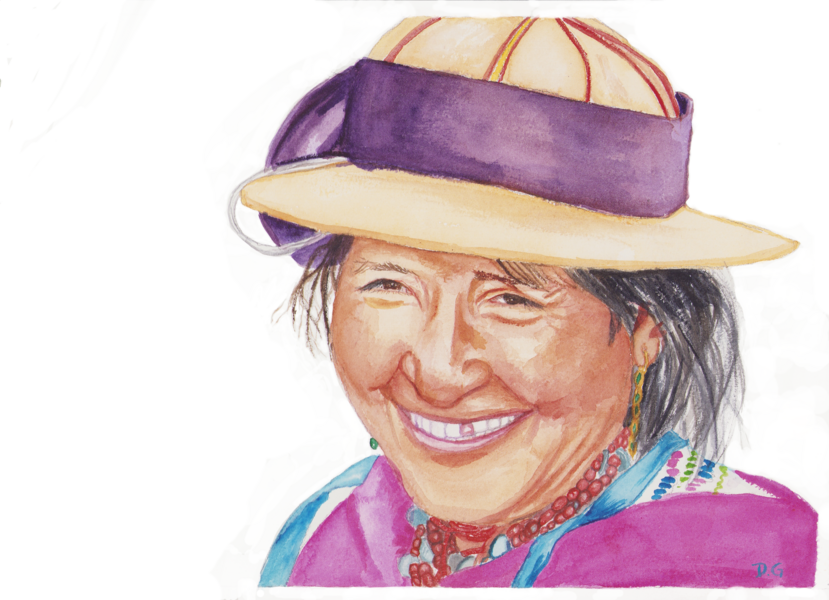 Indigenous Woman of Pulucate Ecuador..jpgIndigenous Woman of Pulucate Ecuador. I always strive to portray the indigenous people of Chimborazo as I saw them in the pictures, I took without editing their physical appearance in the process. Women and men with missing teeth were a common sight. I enjoyed painting this woman because she expressed true joy on her face and seemed unbothered by showing her smile. Which I see as a life lesson because the indigenous people of this province that I met mostly had three things in common. First their generosity, sense of community, and their ability to enjoy the present. Despite their troubles, extreme poverty, etc.
Indigenous Woman of Pulucate Ecuador..jpgIndigenous Woman of Pulucate Ecuador. I always strive to portray the indigenous people of Chimborazo as I saw them in the pictures, I took without editing their physical appearance in the process. Women and men with missing teeth were a common sight. I enjoyed painting this woman because she expressed true joy on her face and seemed unbothered by showing her smile. Which I see as a life lesson because the indigenous people of this province that I met mostly had three things in common. First their generosity, sense of community, and their ability to enjoy the present. Despite their troubles, extreme poverty, etc. -
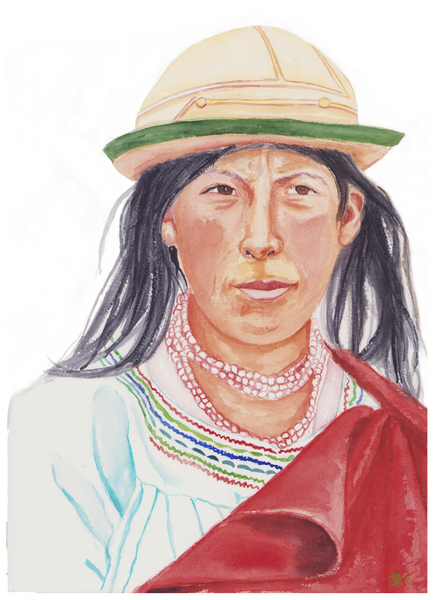 Mother From Santa Teresita Ecuador.jpgMother From Santa Teresita Ecuador. This painting is the second one I've done of this Indigenous mother from Santa Teresita. I remember because the first painting I did of her and her daughter, in acrylics 8-9 years prior to this. I’ve always been drawn to painting people in candid nature because I like my paintings to display a level of human nature that the unkemptness of this mother’s hair portrays. I prefer to portray a real moment rather than a perfectly orchestrated pose with perfect hair and makeup.
Mother From Santa Teresita Ecuador.jpgMother From Santa Teresita Ecuador. This painting is the second one I've done of this Indigenous mother from Santa Teresita. I remember because the first painting I did of her and her daughter, in acrylics 8-9 years prior to this. I’ve always been drawn to painting people in candid nature because I like my paintings to display a level of human nature that the unkemptness of this mother’s hair portrays. I prefer to portray a real moment rather than a perfectly orchestrated pose with perfect hair and makeup. -
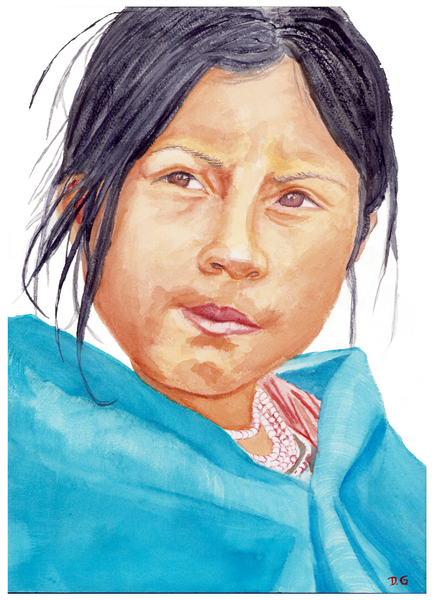 Curious Girl in Blue.jpgCurious Girl in Blue. This is also the second portrait I did of this little girl. The first was an acrylic portrait I did of her in my Jahuay series 8-9 years prior to this. I have at least half a dozen of pictures of her. And I loved painting her because of how she could go through a half dozen of expressions in a matter of minutes. She portrays the same curiosity I feel about learning about my grandmother’s culture.
Curious Girl in Blue.jpgCurious Girl in Blue. This is also the second portrait I did of this little girl. The first was an acrylic portrait I did of her in my Jahuay series 8-9 years prior to this. I have at least half a dozen of pictures of her. And I loved painting her because of how she could go through a half dozen of expressions in a matter of minutes. She portrays the same curiosity I feel about learning about my grandmother’s culture. -
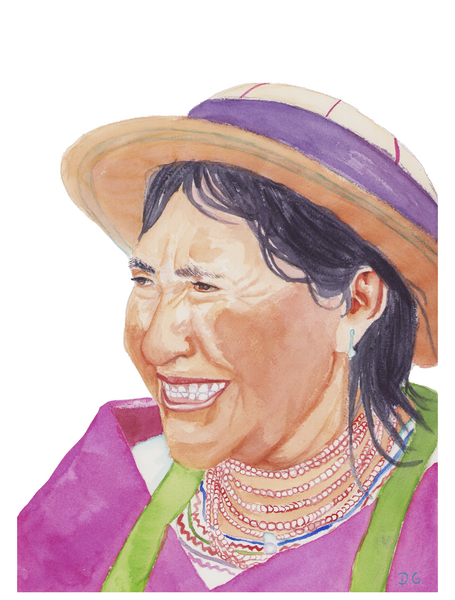 Indigenous Woman of Ecuador with green ribbon.jpgIndigenous Woman of Ecuador with green ribbon. At times I make it a point with highly contrasting color combinations, as an act of rebellion against the derogatory terms and attitudes of the mestizos towards the Indigenous people. Especially towards the women who wear highly contrasting colors together light neon green ribbon with hot pink. While the woman in the photograph was wearing a different colored ribbon, although I can’t remember at the moment. My point is to illustrate indigenous people’s joyful way of life. While there is an Ecuadorian art movement known as the indigenista movement, that focuses on the indigenous people, the themes are struggle,pain, and darkness. While I support indigenous movements towards having better rights and living conditions and the right to have leaders in the government. Which they have gotten in recent years. I am also of the belief that the colors and the vibrancy of their traditions should be celebrated and recognized.
Indigenous Woman of Ecuador with green ribbon.jpgIndigenous Woman of Ecuador with green ribbon. At times I make it a point with highly contrasting color combinations, as an act of rebellion against the derogatory terms and attitudes of the mestizos towards the Indigenous people. Especially towards the women who wear highly contrasting colors together light neon green ribbon with hot pink. While the woman in the photograph was wearing a different colored ribbon, although I can’t remember at the moment. My point is to illustrate indigenous people’s joyful way of life. While there is an Ecuadorian art movement known as the indigenista movement, that focuses on the indigenous people, the themes are struggle,pain, and darkness. While I support indigenous movements towards having better rights and living conditions and the right to have leaders in the government. Which they have gotten in recent years. I am also of the belief that the colors and the vibrancy of their traditions should be celebrated and recognized. -
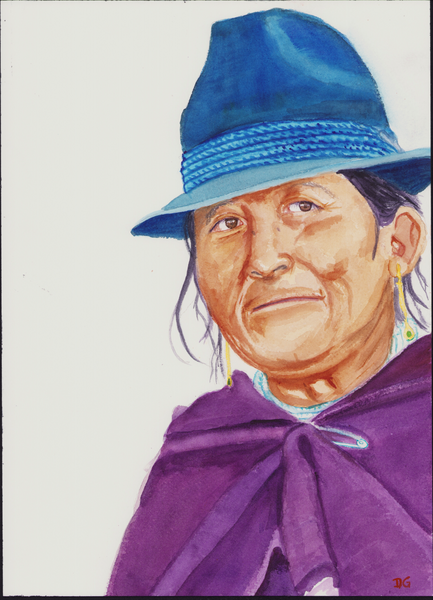 Day 5 of 10 Day Watercolor Challenge.jpgIndigenous woman of Ecuador in plum. I remember the day we met this woman in Santa Teresita. She was quiet but exuded kindness; I remember I took several pictures of her, and I knew that I wanted to paint her because she just made me feel at peace to be there among a bunch of strangers. In my head looking back I think maybe she could have been like an aunt or a great-aunt. I can’t really know because we know so little about my grandmother’s family.
Day 5 of 10 Day Watercolor Challenge.jpgIndigenous woman of Ecuador in plum. I remember the day we met this woman in Santa Teresita. She was quiet but exuded kindness; I remember I took several pictures of her, and I knew that I wanted to paint her because she just made me feel at peace to be there among a bunch of strangers. In my head looking back I think maybe she could have been like an aunt or a great-aunt. I can’t really know because we know so little about my grandmother’s family. -
 Day 6 10 Day Challenge.jpgIndigenous girl carrying little sister. I made this a repeating theme of older sisters carrying their younger siblings, because it is very common to see, within these indigenous communities. In this second painting of a sister carrying her sibling, I painted them on a full-body scale. To give the proportions of the weight of these young girls in comparison to their younger siblings. In this one as opposed to my first attempt, you get to see how thick and chubby the whole baby is and how they are slouching on the sister's back. The older sister’s back is slightly bent forward to be able to support the weight. I am often marveled and how much weight the women are trained to carry on their backs, up and down the very steep hills/ mountains of the Andes. * Currently in a private collection in Maryland
Day 6 10 Day Challenge.jpgIndigenous girl carrying little sister. I made this a repeating theme of older sisters carrying their younger siblings, because it is very common to see, within these indigenous communities. In this second painting of a sister carrying her sibling, I painted them on a full-body scale. To give the proportions of the weight of these young girls in comparison to their younger siblings. In this one as opposed to my first attempt, you get to see how thick and chubby the whole baby is and how they are slouching on the sister's back. The older sister’s back is slightly bent forward to be able to support the weight. I am often marveled and how much weight the women are trained to carry on their backs, up and down the very steep hills/ mountains of the Andes. * Currently in a private collection in Maryland -
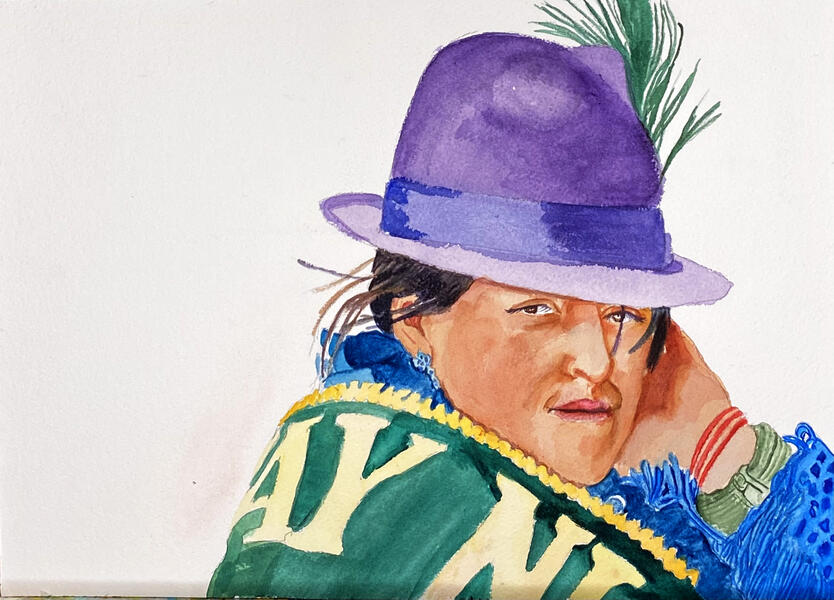 Day 8 of 10 day portrait Chalenge .jpgBeauty Queen. People in the Chimborazo Province, both mestizos, and indigenous people, often have big town/community parties where a queen or a madrina ( godmother), or Padrino ( godfather) is chosen for the celebration. These padrinos / godfathers, and Queens are selected to be the sponsors/hosts of their upcoming parties in that town or community. They are given a sash like the one woman in this painting is wearing.
Day 8 of 10 day portrait Chalenge .jpgBeauty Queen. People in the Chimborazo Province, both mestizos, and indigenous people, often have big town/community parties where a queen or a madrina ( godmother), or Padrino ( godfather) is chosen for the celebration. These padrinos / godfathers, and Queens are selected to be the sponsors/hosts of their upcoming parties in that town or community. They are given a sash like the one woman in this painting is wearing.
Pasese del Niño ( Three Kings Day, Jan 6th) impromptu parades, ongoing
And I have always held in the back of my mind the desire to paint , and learn more about the indigenous, mestizo characters that make up this festive colorful and utterly unique event of Chimborazo. I started by painting the Curiquingui, the bird character, and the Danzante the indigenous, priest like character. In addition to the Riobambeñan Devil/ the Supay, of which I started an individual series for. Both series have been on standby due to the need of more , field research, and the financial means to bring these projects and a few others to fruition.
-
Danzante.JPGDanzante. The Danzante character ( dancer )is a huge part of the “ Pases del Niño” inpromtune parades that the city of Riobamba, Ecuador has every year for the Día de Reyes (Three Kings Day) on January 6th! He’s also some kinds of a priest like character for the indigenous people of the Chimborazo Province where Riobamba is located . This commission brought me lots hope and helped me face some difficult times in my life while also bringing me great joy in its creation .
-
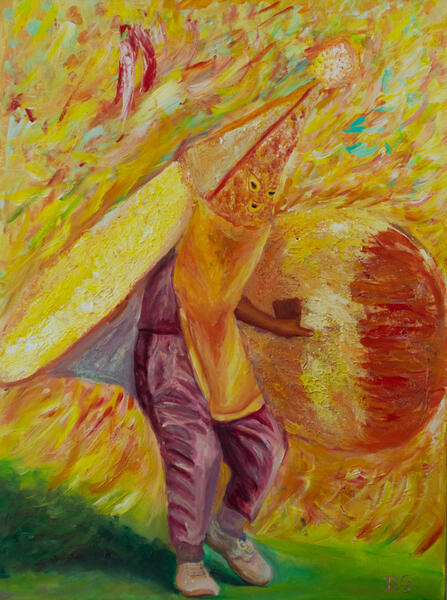 .jpgCuriquingue.The Curiquingui is a ceremonial bird traditional of the Andean Indigenous people of the Chimborazo Province of Ecuador. The Curiquingui is a bird character that is seen in the Pases del Niño, Three Kings’ Day parades in Riobamba Ecuador. I have always loved this character and how colorful and diverse the costumes can be. You see in Riobamba “ Los Pases de Niño, are Impromptu parades ranging from Late November till Carnaval which usually falls in February. The main parade happens on Jan 6th each year celebrating Three Kings’ Day. I’m happy to say that one of my cousin’s sons dances as one of these characters every year. His grandfather’s family has a dance group where they all dress up as Curiquingui every year. They even get hired to do special events out of town! *
.jpgCuriquingue.The Curiquingui is a ceremonial bird traditional of the Andean Indigenous people of the Chimborazo Province of Ecuador. The Curiquingui is a bird character that is seen in the Pases del Niño, Three Kings’ Day parades in Riobamba Ecuador. I have always loved this character and how colorful and diverse the costumes can be. You see in Riobamba “ Los Pases de Niño, are Impromptu parades ranging from Late November till Carnaval which usually falls in February. The main parade happens on Jan 6th each year celebrating Three Kings’ Day. I’m happy to say that one of my cousin’s sons dances as one of these characters every year. His grandfather’s family has a dance group where they all dress up as Curiquingui every year. They even get hired to do special events out of town! *
The Supay ( Riobambeñean Devil) 2015-ongoing)
The (Supay) Riobambeñean devil is unique to the Chimborazo Province of Ecuador. I fell in love with this character when I first took pictures of them in the 2012 at Three Kings Day parade. I am currently in the early stages of research of my project. I have some paintings for my series. I have been culturally familiar with this figure for the past 10 years, but I want to uncover its historical origins, through my art and research. The past few years I have realized that the paintings need a complementary part to clarify the culturally secular aspect of this character, through illustrated stories. I want to research any unclear and overlapping beliefs of this figure in the Christian religion with the cosmological indigenous beliefs.
The stories will explore themes of human duality. One of the stories will center on how this character was (is) thought to be the spiritual guide that choose who to bless within the community to become a musician or a crafter. I seek to express this mischievous/spiritual creative guide that it represents for the indigenous / mestizo culture in Riobamba. In addition to why it is considered a guardian of the people, as someone who keeps the peace during the Christmas parades. I also want to uncover the mysteries that surround the origin of this character within the community. Finally I want to publish a book of stories and exhibit my painting series.
-
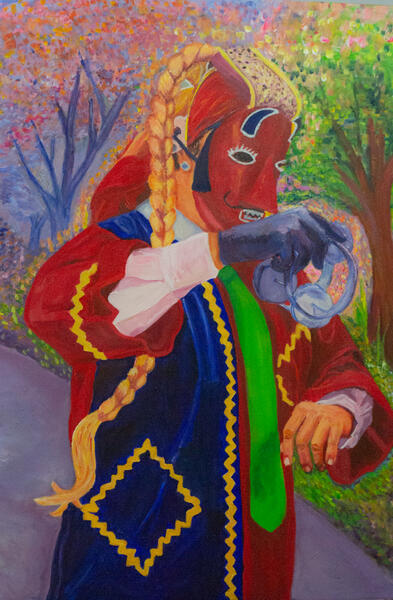 Diablita Daniela Godoy 2018.jpgDiablita Riobambeña, Female Dancing Devil.The Supay however is not linked to religion or the religious characteristics that other cultures have for devil figures. One of the most visible representations of the dualities the Diablo Riobambeño is an ambiguous gender. Its femininity is represented in the long braid that all the Supay wear, in addition to the shawls that they wrap around their waist and double as skirts which are worn on top of slacks. The mask represents the masculine aspect with the beard and goatee. Both men and women wear this costume, unlike other characters in the parade thus showing their androgynous nature.
Diablita Daniela Godoy 2018.jpgDiablita Riobambeña, Female Dancing Devil.The Supay however is not linked to religion or the religious characteristics that other cultures have for devil figures. One of the most visible representations of the dualities the Diablo Riobambeño is an ambiguous gender. Its femininity is represented in the long braid that all the Supay wear, in addition to the shawls that they wrap around their waist and double as skirts which are worn on top of slacks. The mask represents the masculine aspect with the beard and goatee. Both men and women wear this costume, unlike other characters in the parade thus showing their androgynous nature. -
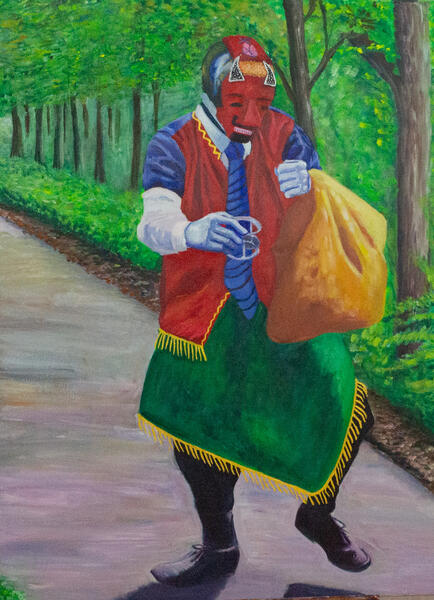 2.Dancing Devil, Daniela Godoy.jpgDiablito Bailarin/ Dancing Devil, This is the Supay/ or Diablito Riobambeño, which is commonly seen during the Three Kings Day parades (January 6th or Pases del Niño) as they are known in Ecuador. Pases del Niño are impromptu parades ranging from Late November till Carnaval which usually falls in February in honor of Christmas celebrations in the Chimborazo Region of Ecuador. The Supay plays a myriad of roles that express our duality in nature. In 2017 the Institute of Cultural Patrimony of Ecuador certified these parades as a Cultural Patrimony of Ecuador, which includes this Riobambeñean devil.
2.Dancing Devil, Daniela Godoy.jpgDiablito Bailarin/ Dancing Devil, This is the Supay/ or Diablito Riobambeño, which is commonly seen during the Three Kings Day parades (January 6th or Pases del Niño) as they are known in Ecuador. Pases del Niño are impromptu parades ranging from Late November till Carnaval which usually falls in February in honor of Christmas celebrations in the Chimborazo Region of Ecuador. The Supay plays a myriad of roles that express our duality in nature. In 2017 the Institute of Cultural Patrimony of Ecuador certified these parades as a Cultural Patrimony of Ecuador, which includes this Riobambeñean devil. -
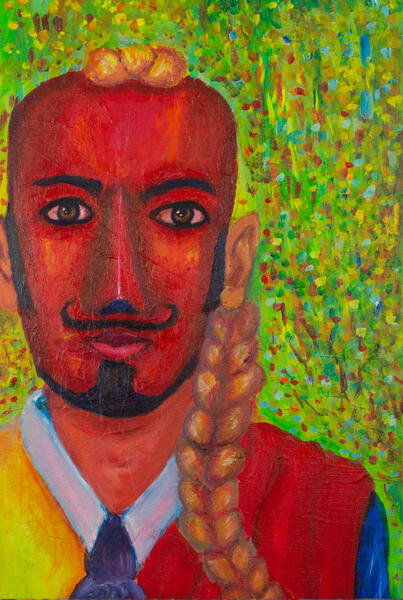 Supay portrait 2019.jpgPortrait of a Supay, Retrato del Supay.In this portrait painting the Supay figure is looking directly at the viewer. Unlike the other paintings in this portrait, the devil has human lips, which contrasts with the actual masks of the character. In this painting, I was exploring the interaction between the spiritual and the human world that this figure represents. The Supay was thought to bridge the mystical world with the human world because he foretold or blessed/ decided who was destined to be a crafter, weaver, musician, etc. in the indigenous community of the Andean people of the Chimborazo Province of Ecuador.
Supay portrait 2019.jpgPortrait of a Supay, Retrato del Supay.In this portrait painting the Supay figure is looking directly at the viewer. Unlike the other paintings in this portrait, the devil has human lips, which contrasts with the actual masks of the character. In this painting, I was exploring the interaction between the spiritual and the human world that this figure represents. The Supay was thought to bridge the mystical world with the human world because he foretold or blessed/ decided who was destined to be a crafter, weaver, musician, etc. in the indigenous community of the Andean people of the Chimborazo Province of Ecuador. -
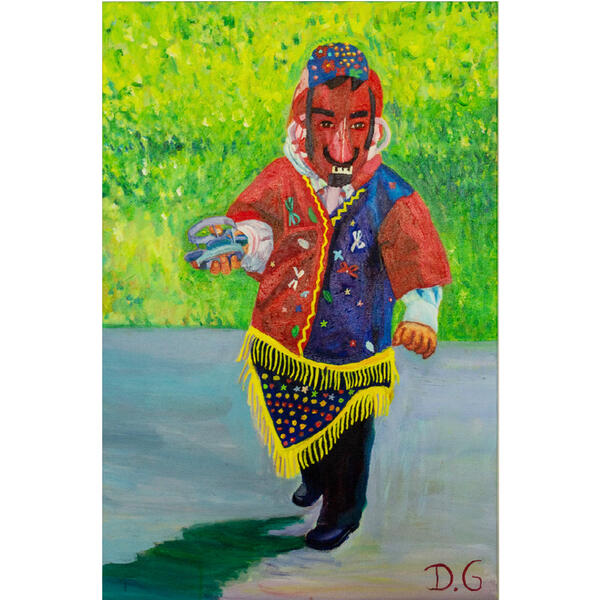 My Post-4.jpgDiablito Chiquito/ Little Devil.This is the smallest Diablito I’ve seen to date in those parades. This little boy couldn’t have been more than two or three years old. It is common to see groups where the entire family dresses up as the Riobambeñean Devil icon. The tradition of this character is passed down generations. It was endearing to see this little one try to follow along with the dancing steps.
My Post-4.jpgDiablito Chiquito/ Little Devil.This is the smallest Diablito I’ve seen to date in those parades. This little boy couldn’t have been more than two or three years old. It is common to see groups where the entire family dresses up as the Riobambeñean Devil icon. The tradition of this character is passed down generations. It was endearing to see this little one try to follow along with the dancing steps. -
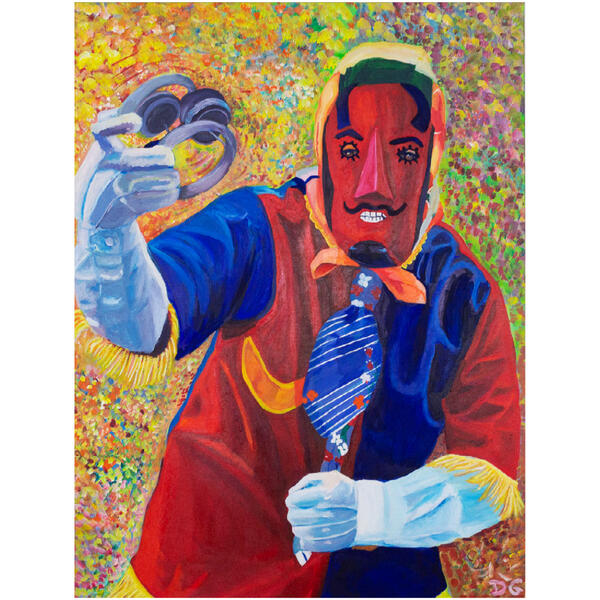 Diablito Jugeton/Playful Devil..jpgDiablito Jugeton/Playful Devil. One of the most appealing things about this Riobambeñean Devil icon is its mischievous playful nature. Unlike most of the dancers at the Three Kings Day parades the Supay are the only ones that actively interact with crowds of people watching the parade. This painting expresses how it’s common for these characters to pose for pictures. One of their roles is to keep the peace during the parade, making sure the audience stays on the sidewalks area and doesn’t interfere with the groups of dancers. They do this by engaging with the audience and dancing with them while pushing them back to the sidewalks.
Diablito Jugeton/Playful Devil..jpgDiablito Jugeton/Playful Devil. One of the most appealing things about this Riobambeñean Devil icon is its mischievous playful nature. Unlike most of the dancers at the Three Kings Day parades the Supay are the only ones that actively interact with crowds of people watching the parade. This painting expresses how it’s common for these characters to pose for pictures. One of their roles is to keep the peace during the parade, making sure the audience stays on the sidewalks area and doesn’t interfere with the groups of dancers. They do this by engaging with the audience and dancing with them while pushing them back to the sidewalks.






























